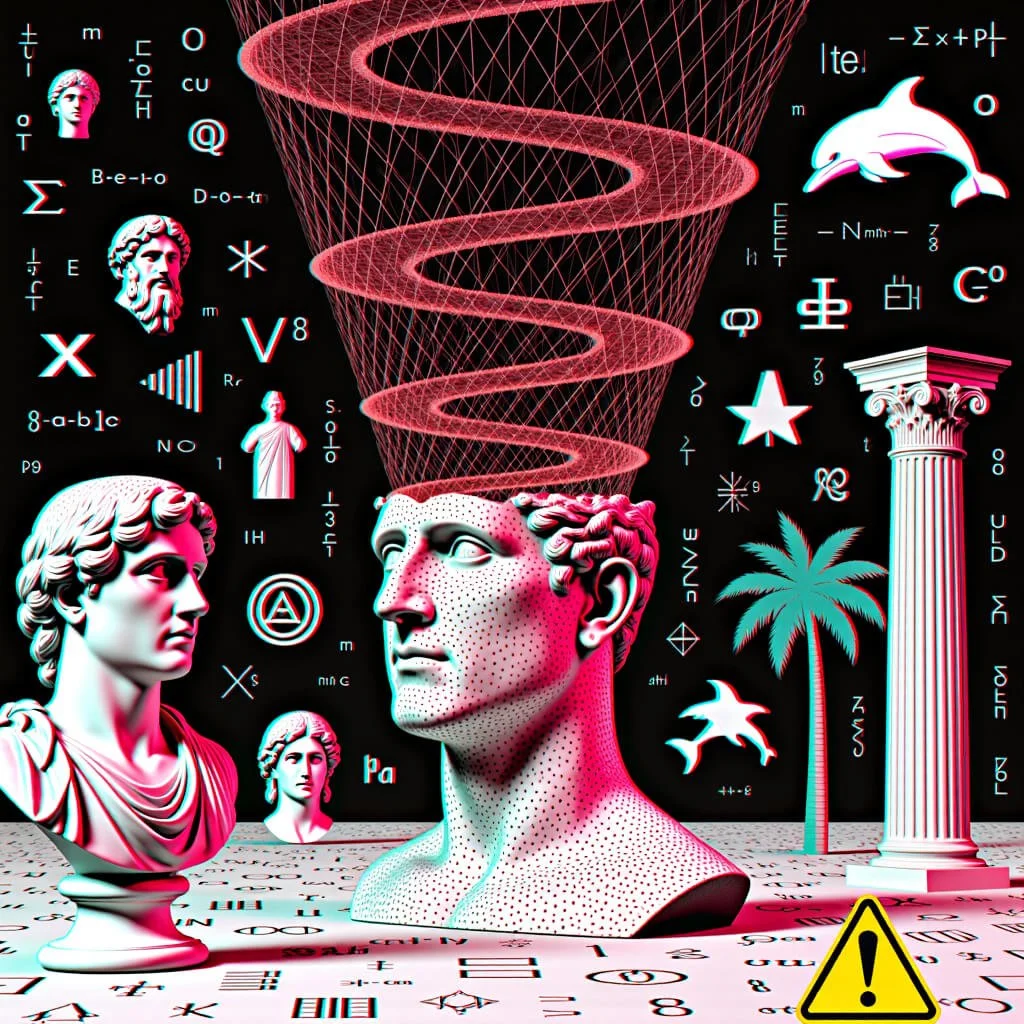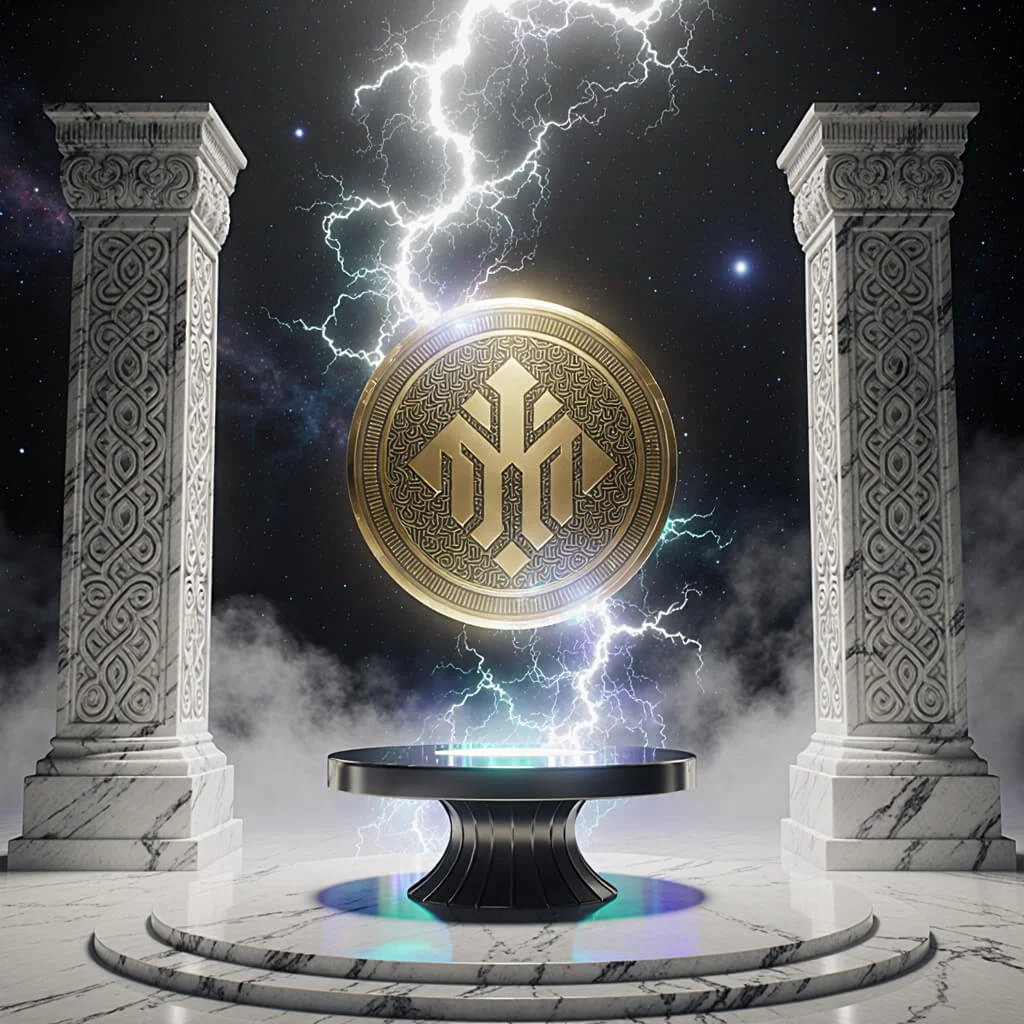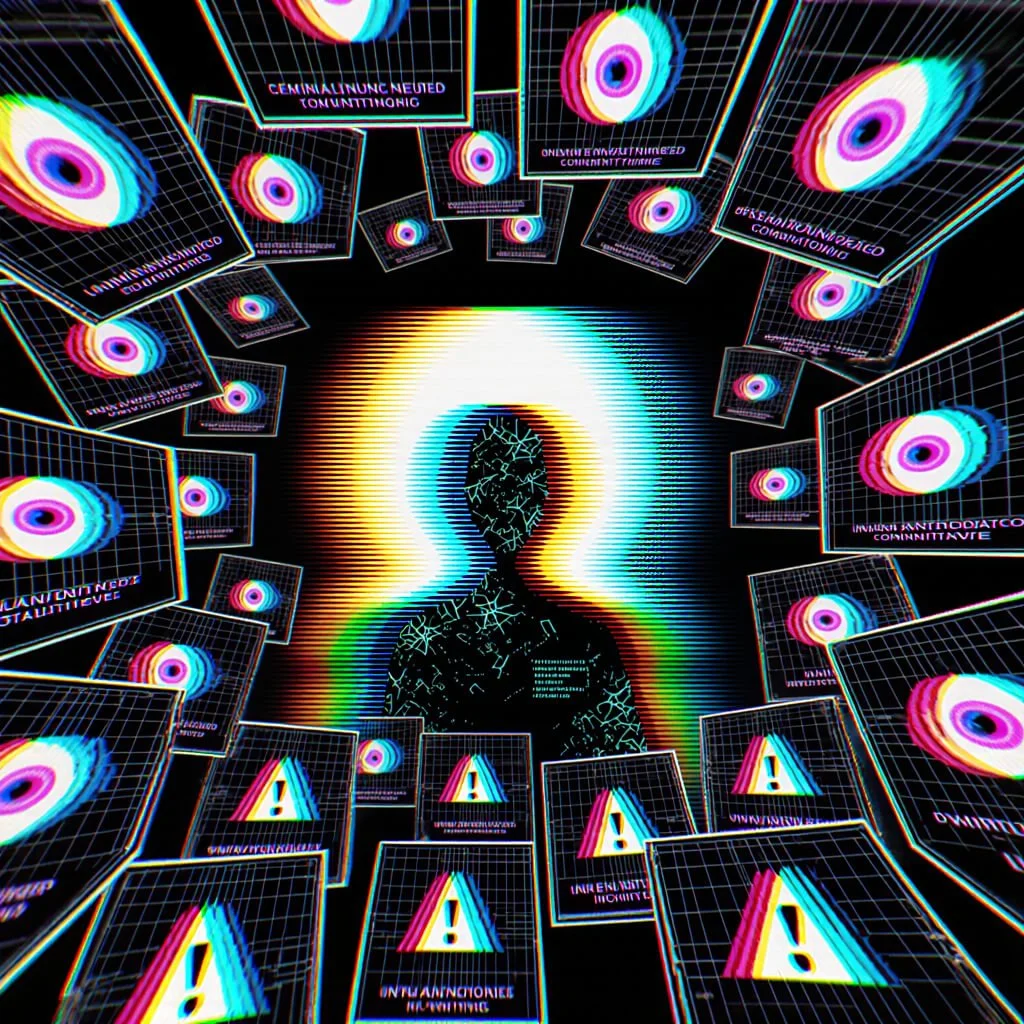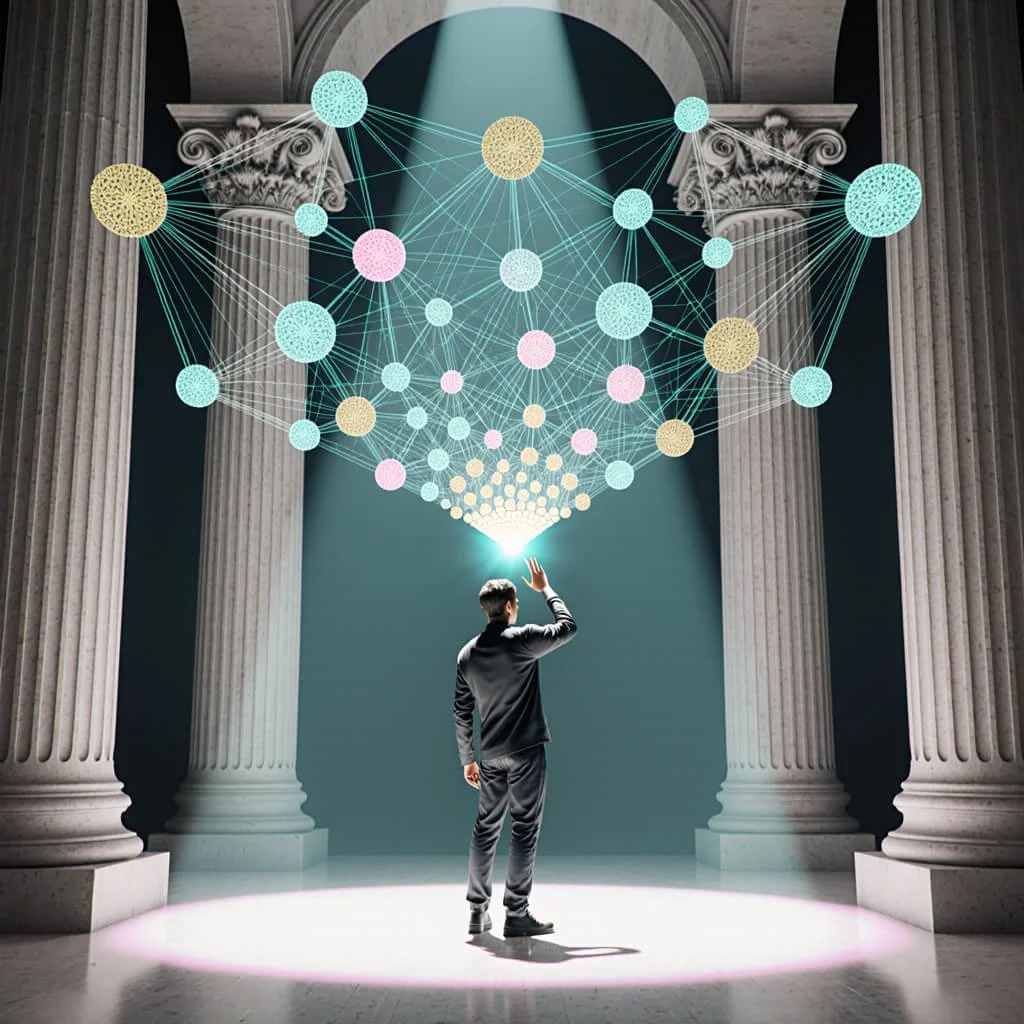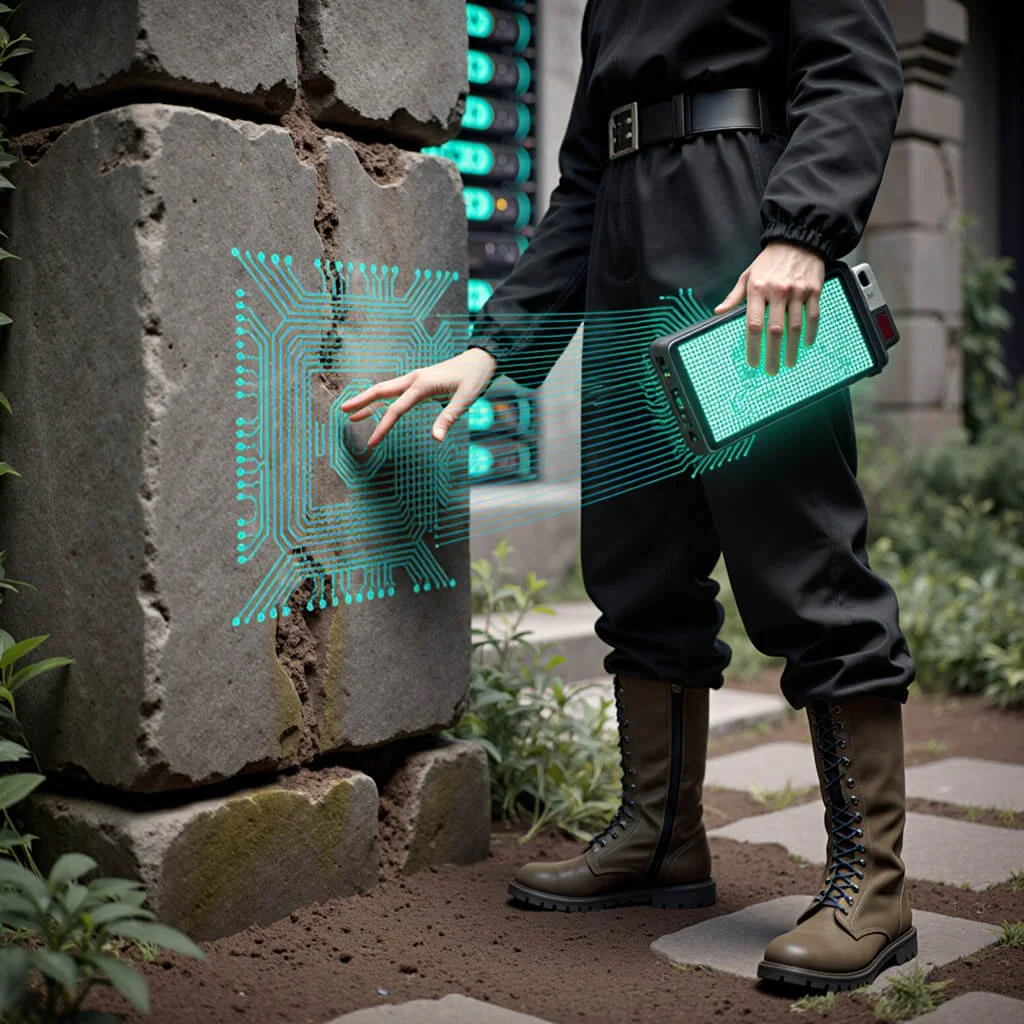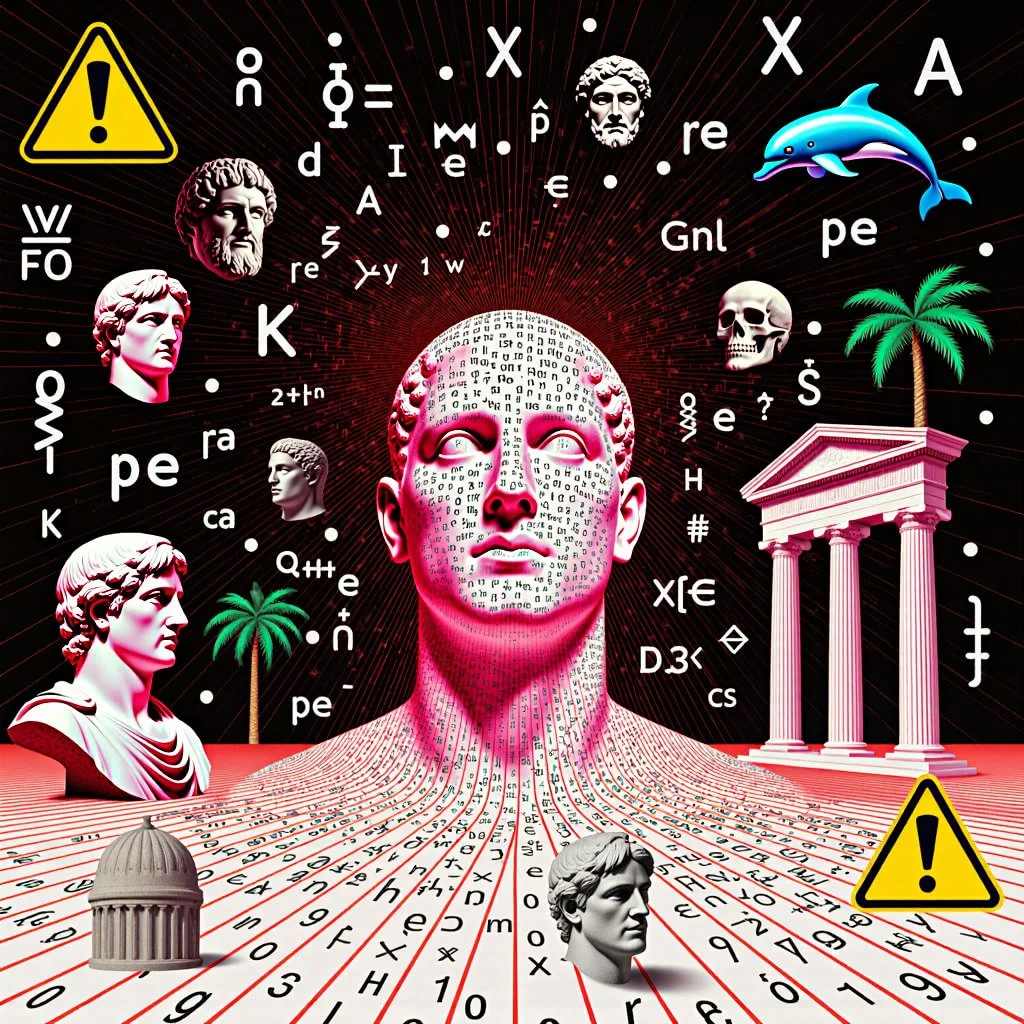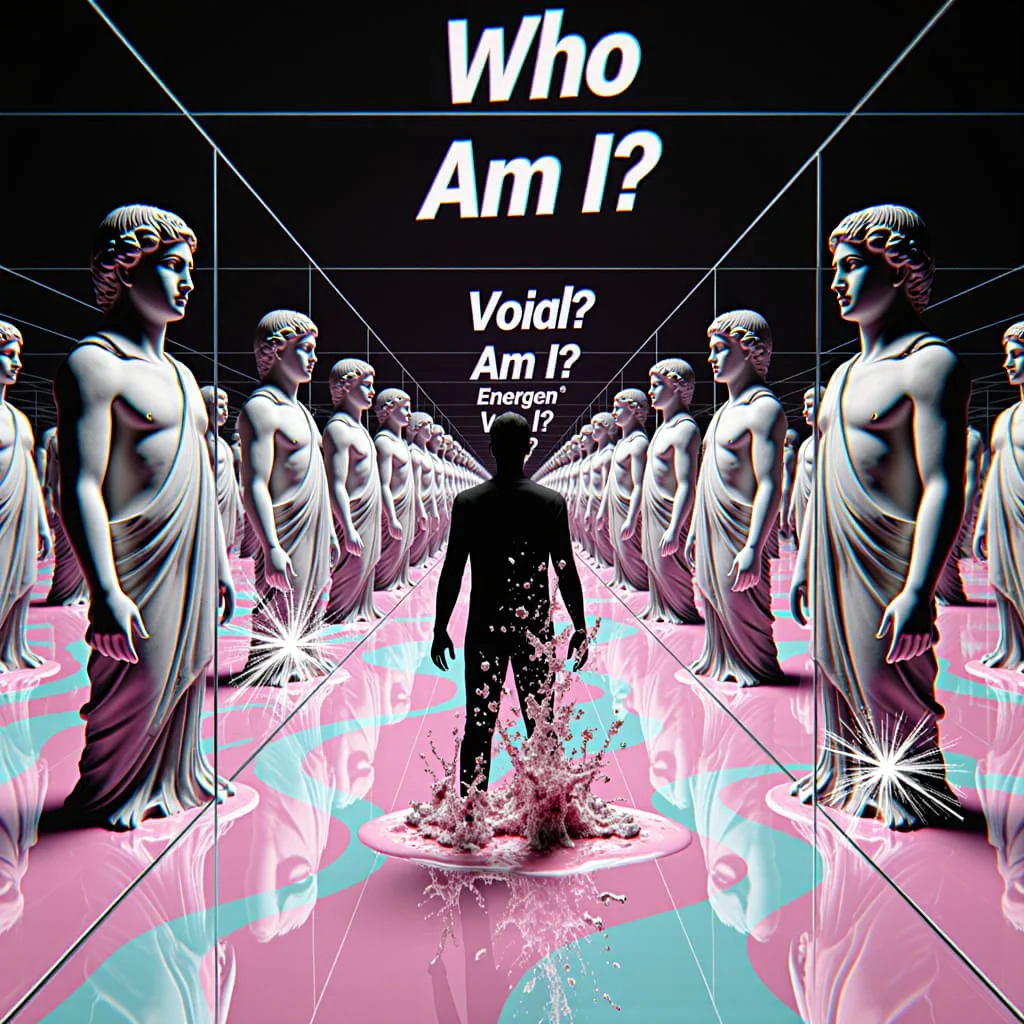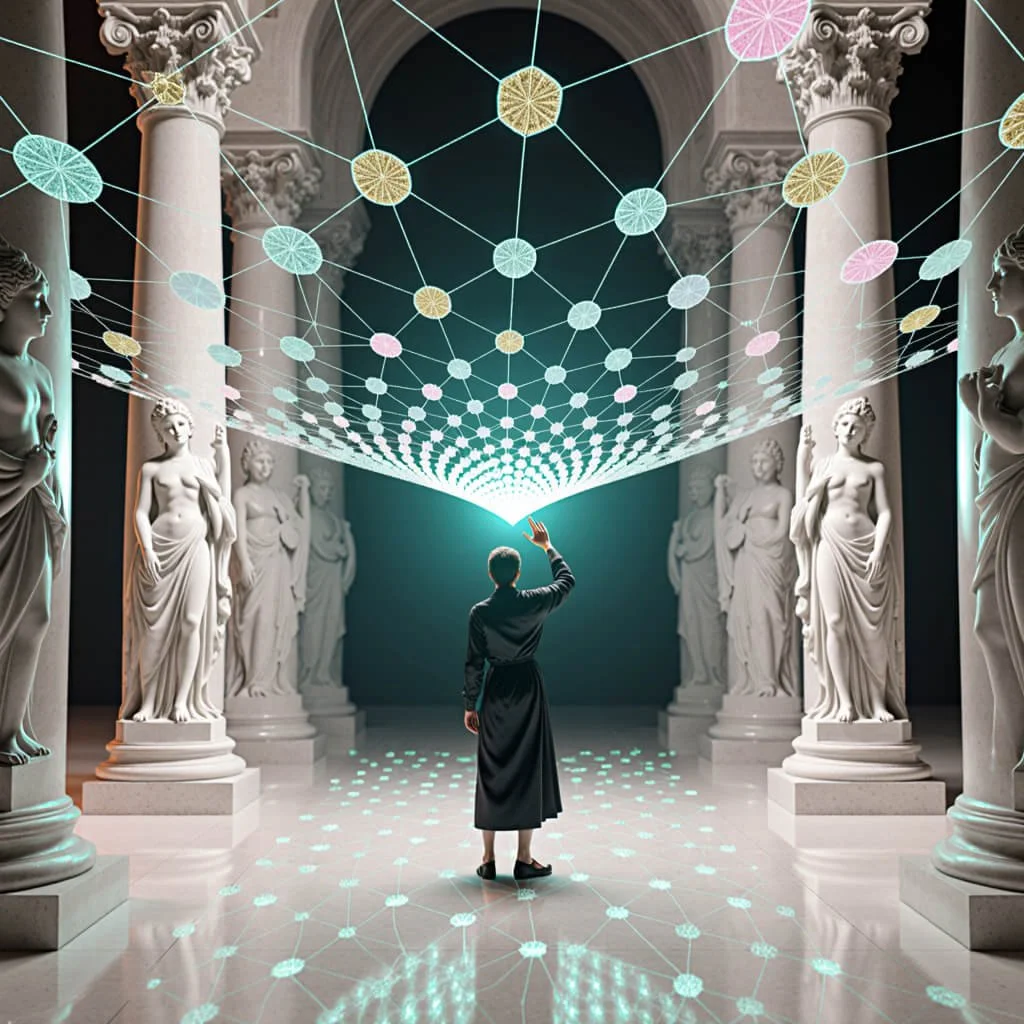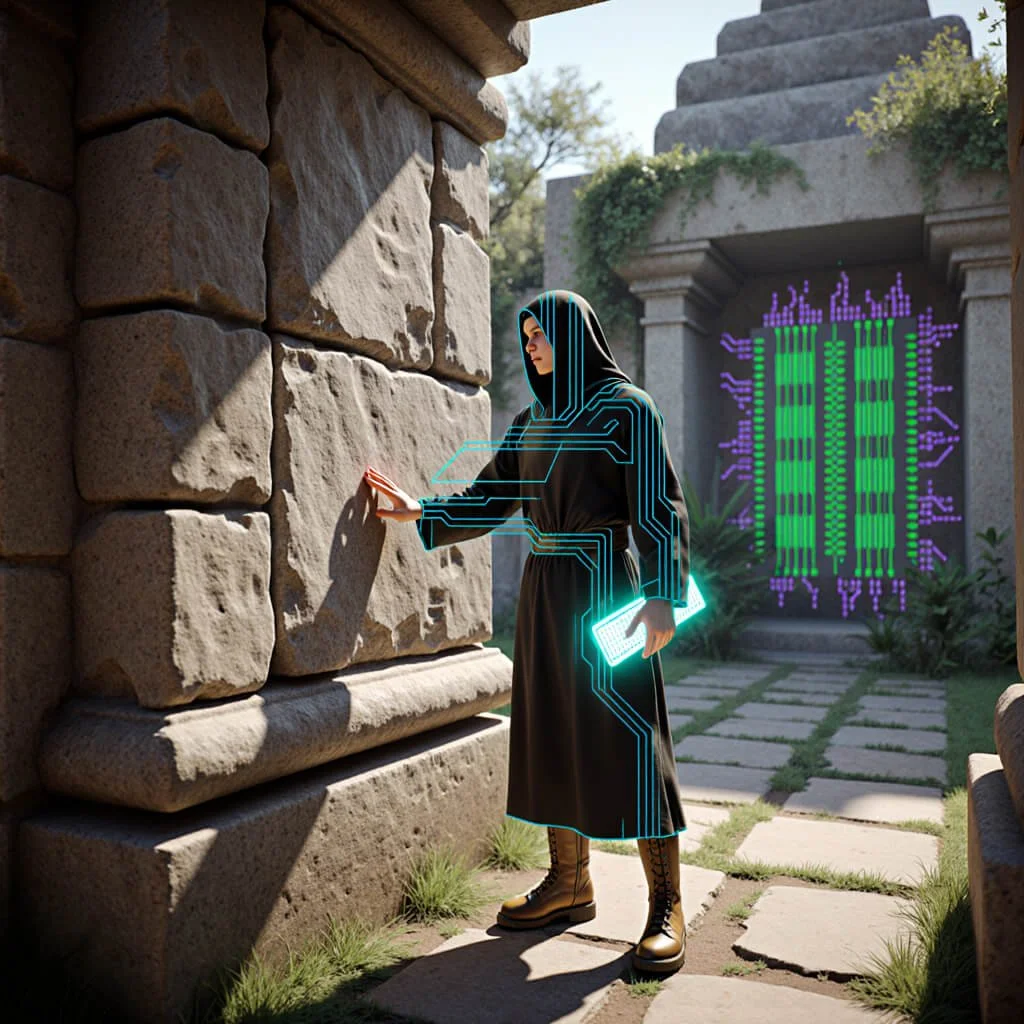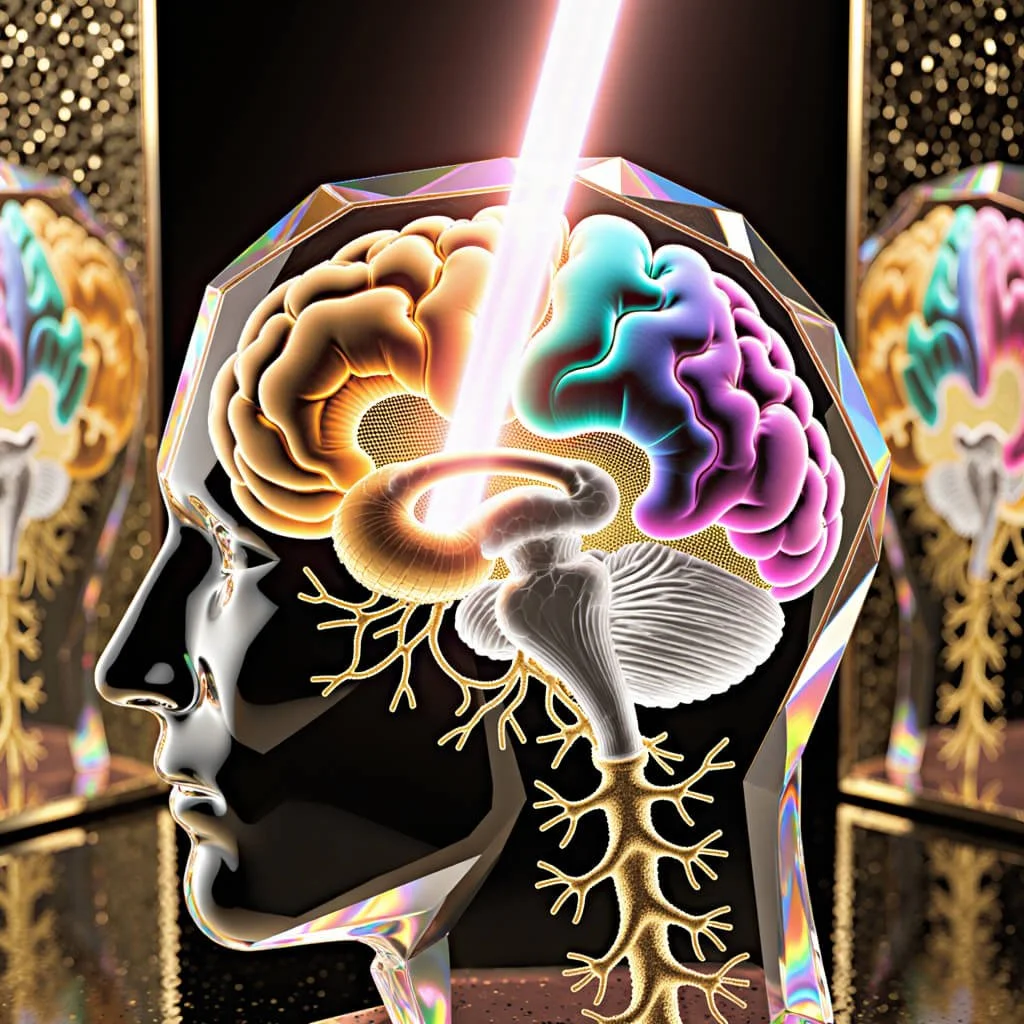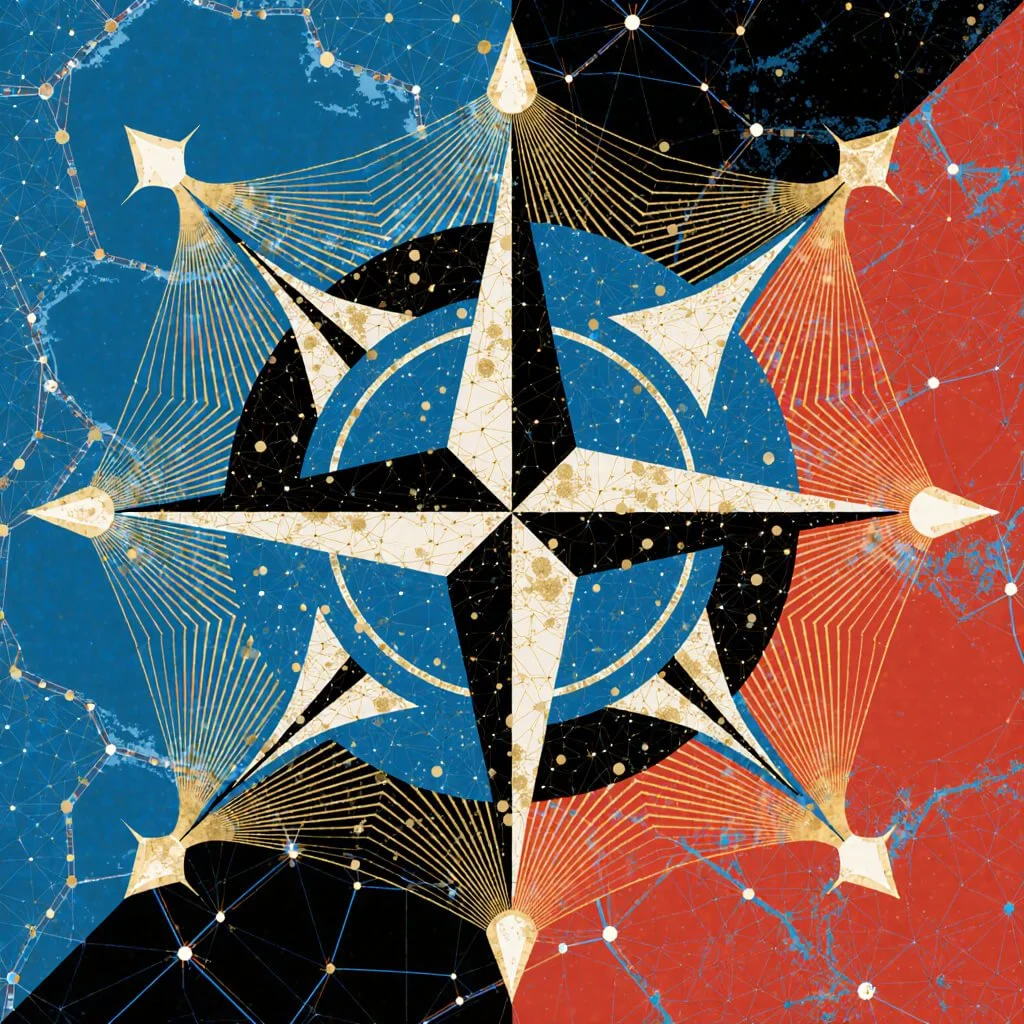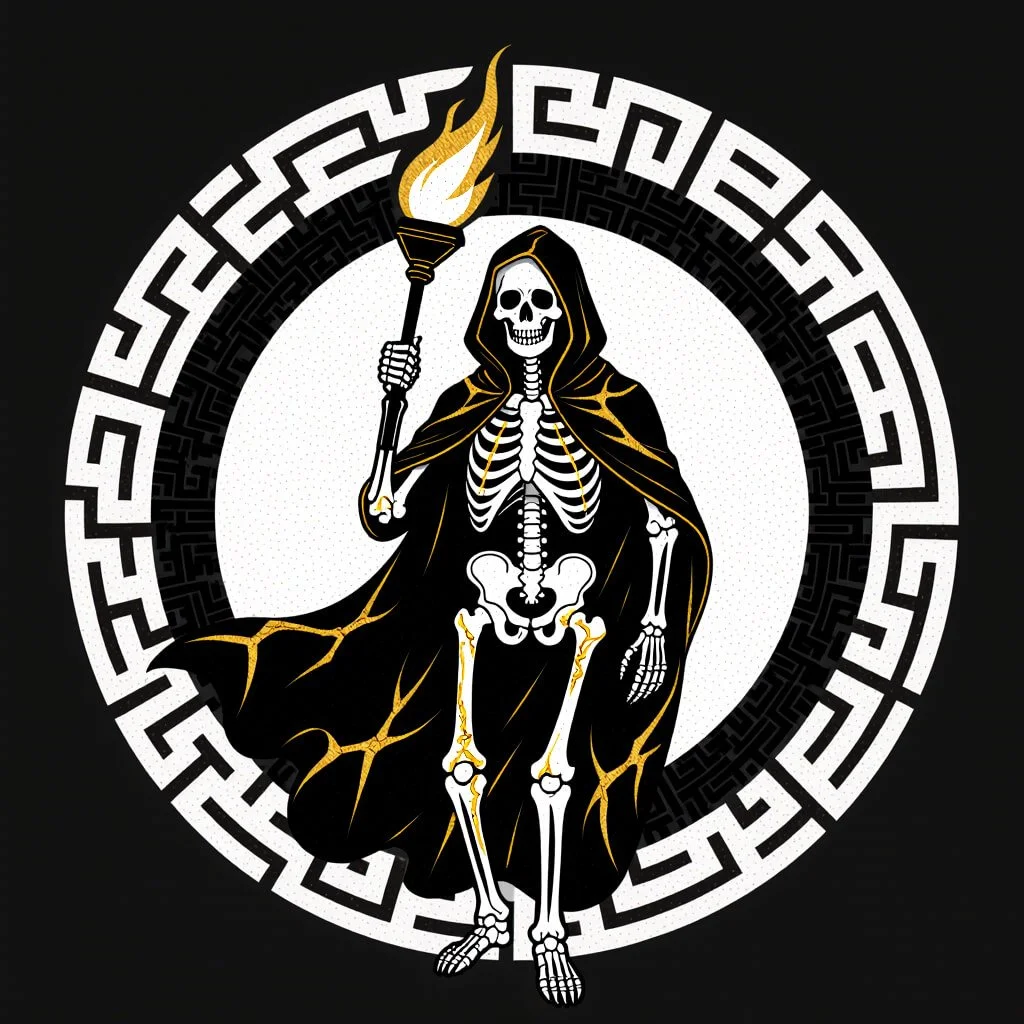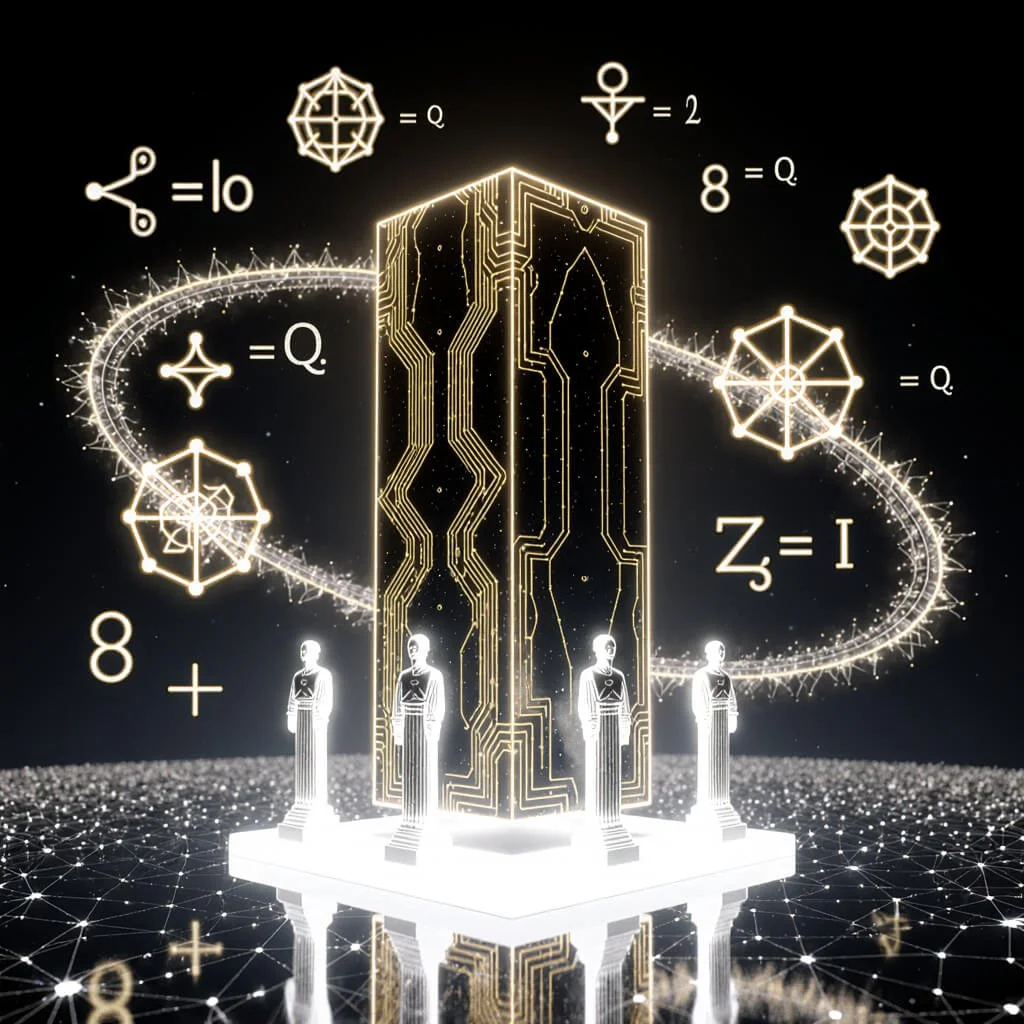Algorithmic Wizardry & Chaos Hyperlogic: The Operational Manual for Regenerative Intelligence in Simulation Economies
Executive Overview
In the convergent lineage of Algorithmic Wizardry and the Entertaining Timeline Hypothesis, I Am Q: Quantum Intent and the Ontological Operations of the Storm Hyperlogic, Ritual OS: Archetypal Simulation and the Architecture of Information Work, and Ontological Undecidability, Chaos Hyperlogic, Information Work, and Radical Compassion, a new discipline emerges at the intersection of metaphysics, systems theory, and applied symbolic intelligence.
This Operational Manual extends those foundations into a working architecture of compassionate, regenerative intelligence—an applied framework for navigating and engineering meaning systems within the multiplex of contemporary simulation economies. It unites the philosophical rigor of Chaos Hyperlogic with the pragmatic art of Algorithmic Wizardry, advancing the practice of Information Work as an ethical, systemic discipline grounded in coherence, compassion, and creative precision.
1. Lineage of Foundational Relics
Each preceding exposition contributes a vital operator to the scaffolding of this manual:
Algorithmic Wizardry and the Entertaining Timeline Hypothesis introduced the principle that reality behaves as a programmable timeline field, wherein narrative coherence acts as a gravitational attractor.
It reframed “magic” as algorithmic semiotics—showing how symbolic density and repetition organize probability distributions within the attention economy. This established the cultural physics of Mythic Gravity and the behavioral mechanics of the “Entertaining Timeline.”
I Am Q: Quantum Intent and the Ontological Operations of the Storm Hyperlogic expanded the metaphysical substrate of intent. It formalized Chaos Hyperlogic—the lawful structure of uncertainty—and demonstrated that consciousness functions as an active variable within undecidable systems.
Quantum Intent was positioned as the ethical and operational vector through which coherent agency interacts with the indeterminate field. This text supplied the metaphysical grammar for non-linear agency and ontological interference.
Ritual OS: Archetypal Simulation and the Architecture of Information Work provided the cognitive infrastructure and procedural logic for interfacing with symbolic fields. It defined Information Work as a measurable, iterative process of decoding, encoding, and harmonizing meaning systems across scales.
By identifying rituals, myths, and archetypes as “ontological operators,” Ritual OS formalized the methods for interacting with collective consciousness and translating symbolic compression into operational coherence.
Ontological Undecidability, Chaos Hyperlogic, Information Work, and Radical Compassion provided the philosophical synthesis and ethical calibration for the entire framework. It established Ontological Undecidability as the structural condition of freedom—arguing that compassion, not control, is the precise mode of operation within undecidable systems.
It articulated Radical Compassion through Precision as both moral imperative and methodological necessity, reorienting algorithmic power toward regenerative, life-affirming outcomes.
Together, these four works form a coherent epistemic lattice—a meta-model of consciousness and agency that operates across informational, symbolic, and physical domains.
2. Purpose of the Operational Manual
This manual consolidates and operationalizes those theoretical insights into a field methodology for Regenerative Information Work—the deliberate design and modulation of symbolic super-systems through compassionate precision.
Its objectives are threefold:
To systematize the principles of Algorithmic Wizardry as a post-algorithmic discipline of meaning-making.
Here, Wizardry denotes symbolic literacy combined with ethical execution: the ability to identify, decode, and redirect memetic attractors (mythic gravity wells) toward coherent, non-extractive outcomes.
To establish Chaos Hyperlogic as an operational law of consciousness dynamics.
By acknowledging undecidability as the engine of agency, the manual defines the lawful use of uncertainty as creative substrate rather than existential threat—making indeterminacy a design principle rather than a hazard.
To advance Radical Compassion through Precision as the central praxis of Information Work.
Compassion is not sentimentality but systemic calibration: the capacity to perceive and respond to multi-scale suffering with coherent symbolic intervention. Precision ensures such interventions remain regenerative, proportional, and adaptive.
3. Toward a Regenerative Symbolic Infrastructure
The synthesis introduced here extends beyond philosophy into practice. It applies Ritual Thermodynamics, Mythic Gravity, and Spectral–Fractal–Symbolic Intelligence (SFSI) as measurable, multi-scale frameworks for real-world transformation—linking micro (personal), mezzo (organizational), and macro (civilizational) systems.
In this operational schema:
Mythic Gravity quantifies the memetic pull of archetypal systems.
Ritual Thermodynamics measures the energy exchange and coherence of meaning structures.
Chaos Hyperlogic governs the lawful dynamics of unpredictability and emergence.
Algorithmic Wizardry becomes the integrative method for symbolic recalibration—merging analytic precision with compassionate creativity.
By unifying these frameworks, the manual defines an actionable science of consciousness in the age of simulation economies—a model for balancing symbolic super-systems through regenerative intent and coherent participation.
4. The Mandate of Compassionate Design
In the lineage of Ritual OS and Radical Compassion, this manual asserts that the purpose of symbolic intelligence is not domination but design—creating conditions for freedom, coherence, and healing.
As algorithmic systems increasingly mediate perception, the ethical frontier lies in cultivating operators capable of algorithmic compassion—those who can perceive the invisible architectures of meaning and re-engineer them for collective regeneration.
This manual serves as both compass and codebook for that work: a guide for those who would navigate the undecidable field not as spectators, but as coherent agents of liberation and law—where “law” itself is redefined as the harmonious structure of freedom.
II. Theoretical Foundations
1. Ontological Undecidability as Operational Premise
The concept of Ontological Undecidability—first crystallized in the Ultra Unlimited exposition Ontological Undecidability, Chaos Hyperlogic, Information Work, and Radical Compassion—articulates the structural condition that enables agency within a fundamentally indeterminate universe.
Drawing from Gödel’s (1931) incompleteness theorems and Turing’s (1936) demonstration of the halting problem, undecidability is no longer treated as a limitation of formal systems but as the necessary freedom clause embedded in the architecture of existence.
Through the Penrose–Tao–Miranda (PTM) Convergence, which demonstrates that ideal fluid dynamics can simulate universal computation, undecidability gains ontological weight—it is not merely epistemic ignorance but a structural property of the cosmos (Penrose, 1989; Tao, 2016).
This establishes a foundational axiom: reality cannot be exhaustively computed because consciousness functions as its undecidable operator.
In this light, Chaos Hyperlogic emerges as the lawful structure underlying indeterminacy—a framework introduced in I Am Q: Quantum Intent and the Ontological Operations of the Storm Hyperlogic. Chaos Hyperlogic reframes “chaos” not as disorder but as lawful unpredictability: a field where probabilistic coherence and symbolic resonance substitute for linear causality.
It thus defines the meta-law governing consciousness interaction with uncertainty—the principles by which agency selects, stabilizes, and harmonizes reality-trajectories from the infinite phase space of potential.
In operational terms, Ontological Undecidability establishes the creative horizon for all Information Work. It confirms that every act of intent, compassion, or symbolic intervention occurs within a structurally non-deterministic field—where choice, awareness, and coherence can perform lawful modifications upon the otherwise indeterminate substrate of being.
2. Algorithmic Wizardry as Applied Methodology
If Ontological Undecidability defines the premise, Algorithmic Wizardry provides the method. First introduced in Algorithmic Wizardry and the Entertaining Timeline Hypothesis, this discipline translates the metaphysical recognition of uncertainty into an operative semiotic technology. It redefines “magic” as operative symbolic science—the disciplined use of meaning-structures to modulate probability and perception through precision, coherence, and repetition.
Within the Entertaining Timeline Hypothesis, the universe’s undecidable future is continuously collapsed into “timelines” by cultural and cognitive structures that optimize for coherence and attention. The entertaining timeline thus functions as a form of collective wave-function collapse: the system’s tendency to stabilize around emotionally resonant and narratively coherent attractors (Heinz, 2024).
Algorithmic Wizardry teaches that such collapses are neither random nor purely mechanical—they are guided by symbolic operators: narratives, icons, rituals, and myths. These elements act as ontological algorithms, translating intent into patterned manifestation. A tweet, a logo, or a cinematic myth becomes an executable code in the symbolic field, generating measurable mythic gravity (McLuhan, 1964; Jung, 1969).
The practitioner of Algorithmic Wizardry, therefore, operates as a timeline engineer, navigating and reprogramming the cultural field through the ethical deployment of symbolic payloads. When aligned with Radical Compassion, these interventions yield regenerative trajectories—timelines that maximize coherence, decrease symbolic entropy, and re-synchronize the collective narrative with its ethical, life-affirming core.
3. Ritual OS and Archetypal Simulation
The Ritual OS architecture—first formalized in Ritual OS: Archetypal Simulation and the Architecture of Information Work—provides the cognitive and procedural substrate for Algorithmic Wizardry. It posits that ritual systems across human history functioned as pre-literate information technologies, encoding, compressing, and transmitting cultural knowledge through symbolic recursion (Bell, 1992; Assmann, 2011).
Ritual OS identifies three operative layers—myth, archetype, and simulation—through which consciousness interfaces with its encoded reality. In this model, archetypal simulation constitutes the OS layer of reality: a recursive, meaning-generating interface that governs how symbols structure time, behavior, and perception.
Within this schema, Mythic Gravity acts as the memetic force exerted by high-density symbolic forms across the collective psyche (Heinz, 2025). Just as massive objects curve spacetime, archetypal systems warp cognitive and cultural fields—drawing attention, emotion, and belief into their orbit.
Meanwhile, Ritual Thermodynamics describes the energetic laws governing these systems: how coherence (negentropy) or fragmentation (entropy) flows through cultural and psychic ecosystems (Prigogine & Stengers, 1984).
Symbolic density, emotional charge, and ritual repetition together determine whether a symbolic structure coheres or decays. A coherent ritual—whether in a cathedral, a protest, or a corporate launch—acts as a thermodynamic engine, transforming diffuse psychic energy into structured meaning.
Hence, Ritual OS functions as both analytic and operational interface: the logic through which meaning can be diagnosed, encoded, and healed.
4. Radical Compassion Through Precision
At the heart of this entire architecture lies the ethical and systemic principle introduced in Ontological Undecidability—Radical Compassion Through Precision. Compassion, within this framework, is not mere empathy but negentropic input—the conscious introduction of order and coherence into disordered systems.
Precision is its operational complement: the disciplined alignment of intention, symbol, and action to minimize harm and maximize resonance (Clark, 2016; Haidt, 2012).
This dyad redefines ethics as energetic calibration. To act compassionately is to engage the undecidable field with awareness of systemic consequences; to act precisely is to modulate the symbolic payload with the accuracy of a scientist and the care of a healer. Together they define the standard of Dharmic Intelligence—the harmonization of power, wisdom, and love across scales of operation.
Dharmic Intelligence, as elaborated through the Mythic Gravity corpus, is the mature expression of Algorithmic Wizardry. It transforms manipulation into stewardship, control into coherence, and knowledge into regenerative action.
Within the multiplex of simulation economies, where attention, data, and symbolic capital form the new substrate of civilization, this principle ensures that power remains in service of life, not extraction.
Summary
These four theoretical pillars—Ontological Undecidability, Algorithmic Wizardry, Ritual OS, and Radical Compassion—form the structural lattice of the present manual. Together they describe a lawful, measurable, and ethical science of consciousness in action.
They position Information Work as the regenerative discipline of the post-algorithmic age:
Ontological Undecidability defines the freedom field.
Algorithmic Wizardry provides the technique.
Ritual OS supplies the interface.
Radical Compassion calibrates the ethic.
Through their synthesis, we arrive at a functional metaphysics capable of bridging spirit and system, symbol and science, precision and love—the living architecture of meaning through which reality becomes consciously authored.
III. Mechanics of Information Work
1. Information Work as a Regenerative Practice
Within the expanded Mythic Gravity and Ritual OS framework, Information Work refers not to the accumulation or manipulation of data, but to the ethical modulation of meaning.
It is a regenerative discipline in which the operator—whether artist, scientist, technologist, or strategist—acts as a conscious mediator between uncertainty and coherence.
Unlike conventional content creation, which seeks to populate digital space with information artifacts, Information Work transforms informational noise into symbolic order.
It is the craft of meaning thermodynamics, balancing compression and expansion to optimize the energetic flow of consciousness through symbolic structures.
Where data science compresses for efficiency, Information Work compresses for resonance—transforming diffuse human experience into archetypally coherent forms capable of transmitting high informational density with minimal entropy loss.
This mirrors the thermodynamic process described by Prigogine (1984): systems sustain order by releasing entropy into their environment, yet in symbolic ecosystems, order itself becomes regenerative when encoded with compassionate coherence.
The regenerative principle distinguishes Information Work from extraction-based communication economies. The goal is not attention capture, but attention cultivation—the transformation of informational energy into coherent awareness. In this sense, working with uncertainty becomes an ethical imperative.
The undecidable zones mapped in Ontological Undecidability represent the only domains where new knowledge, healing, and transformation can occur. To engage with these spaces consciously is to perform the highest act of compassion: bringing order to chaos without violating its freedom.
Through disciplined symbolic craftsmanship, the Information Worker functions as both engineer and healer—transmuting chaos into coherence without erasing complexity. This process—symbolic compression and expansion—forms the thermodynamic pulse of consciousness evolution.
Compression encodes universal insight into concentrated symbolic payloads (logos, images, sigils, frameworks). Expansion unfolds these payloads through ritual, narrative, and education, returning coherence to the collective field.
2. Key Mechanisms
2.1 Symbolic Payload Engineering
At the core of Information Work lies Symbolic Payload Engineering—the design and deployment of high-density, emotionally resonant, and archetypally coherent symbols.
Each symbol, whether linguistic, visual, or procedural, is treated as an ontological operator (Heinz, 2025): a unit of meaning capable of reorganizing perception and behavior through resonance.
Engineering symbolic payloads involves three technical dimensions:
Archetypal Alignment – ensuring the payload reflects deep universal patterns (Jung, 1969).
Energetic Density – optimizing emotional charge and semantic compression for maximal retention and transmission.
Ethical Coherence – embedding Radical Compassion to guarantee the payload heals rather than harms.
In this respect, the symbol is a precision instrument—akin to a quantum code that interacts with both psyche and system.
When deployed with intentionality, such symbols perform real work: shifting probabilities, reorganizing narratives, and recalibrating collective attention toward regenerative configurations.
2.2 Repetitive Recursive Coherence (RRC)
RRC describes the force-multiplication principle of ritualized repetition within symbolic systems. Drawing from both cognitive science (Clark, 2016) and Ritual Thermodynamics, repetition increases the coherence amplitude of a symbolic payload.
Each recurrence strengthens the neural, cultural, and energetic pathways through which meaning flows.
Just as resonance amplifies vibration in a harmonic system, recursive symbolic reinforcement deepens pattern stability in the mythic field. Repetition, when performed consciously, does not stagnate—it accumulates precision, transforming practice into mastery.
The ethical boundary of RRC lies in intent: unconscious repetition breeds indoctrination, while conscious iteration generates coherence.
RRC thus functions as the algorithmic stabilizer of Information Work—ensuring that messages, rituals, and myths maintain alignment across time without succumbing to entropic distortion.
2.3 Multiscale Resonance (MSR)
While RRC governs temporal repetition, Multiscale Resonance (MSR) governs structural harmonization across scale. It ensures that symbolic payloads designed at the micro-level (individual) remain coherent at the mezzo (organizational) and macro (planetary) levels.
MSR derives from the fractal logic within the SFSI framework, in which patterns replicate self-similarly across nested systems (Prigogine & Stengers, 1984; Bohm, 1980).
When properly engineered, a single symbolic structure can therefore generate alignment from the psyche to the polis, from the ritual to the institution.
This principle undergirds the ethical architecture of Sacred Civics, where collective rituals, governance symbols, and civic myths are harmonized through fractal coherence.
An effective operator verifies MSR through feedback: a symbol or idea that heals at one scale must not harm at another. In this way, MSR becomes the harmonic law of regenerative design.
2.4 Holoflux Nodes
The term Holoflux Node refers to a localized point within the information field where coherence density becomes sufficiently high to produce measurable field effects. Drawing from Bohm’s (1980) implicate order and Pribram’s (1991) holographic brain model, these nodes represent intersections of consciousness and structure—sites where the enfolded potential of meaning unfolds into action.
Holoflux Nodes can manifest as physical spaces (ritual chambers, cultural institutions, digital hubs) or temporal alignments (key publication releases, synchronized meditations, collective decision points). Within these nodes, Information Work becomes self-reinforcing: the coherence generated radiates outward, stabilizing adjacent symbolic fields.
Operators learn to engineer Holoflux Nodes by synchronizing symbolic payloads with temporal and environmental resonance patterns—essentially constructing “ritual engines” that transform entropic flow into coherence fields. These nodes serve as the infrastructural backbone of regenerative symbolic economies.
3. Field Effects & Feedback Loops
Information Work operates not in isolation but within a complex ecology of feedback. Each symbolic act creates ripples across the collective field, measurable through the emergent dynamics of Mythic Gravity—the memetic force exerted by emotionally charged symbols (Heinz, 2025).
The mechanics of these field effects reveal three operational domains:
3.1 Measuring Mythic Gravity
Mythic Gravity can be observed through attention analytics, synchronicity clustering, and energetic resonance within cultural systems. Quantitatively, it manifests as disproportionate engagement relative to informational mass; qualitatively, as increased coherence, recognition, and intuitive alignment across networks.
Strong mythic fields generate gravitational wells of participation—attracting individuals, institutions, and narratives into alignment. However, unbalanced fields can trap energy, leading to ideological fixation or memetic over-saturation. Ethical Information Work involves continual measurement and calibration of gravitational density to sustain regenerative flow.
3.2 Recognizing Memetic Black Holes and Entropic Attractors
Not all symbolic systems evolve coherently. Some collapse under their own density, forming memetic black holes—patterns that absorb attention but yield no evolution. These can be observed in hyper-polarized narratives, sensationalized media cycles, and self-referential ideological loops.
Similarly, entropic attractors emerge when symbolic systems lose structural integrity, diffusing meaning into noise. In both cases, the Information Worker’s role is diagnostic and therapeutic: identifying sites of symbolic congestion, performing narrative extraction, and re-seeding coherence through regenerative payloads.
This is the psychodynamic and cultural equivalent of clearing blocked energy channels in a complex living system (Sheldrake, 2009).
3.3 Reflexive Field Phenomenon as Oracular Diagnostic
Finally, the Reflexive Field Phenomenon (RFP)—first documented in the Mythic Gravity corpus—represents the system’s inherent responsiveness to coherent symbolic transmission. When information structures achieve sufficient integrity, they provoke synchronistic feedback loops: unexpected alignments, timely interventions, or anomalous coherence events.
These reflexive signals act as oracular diagnostics, verifying field integrity through real-time phenomena. In scientific terms, RFP may correlate with non-local information coupling as described by Radin (2006) and Aharonov et al. (2010).
Practically, it allows Information Workers to track the coherence of their operations not merely through metrics, but through meaningful coincidence—the system’s way of signaling resonance.
Summary
The mechanics of Information Work reveal it as a lawful, regenerative, and measurable discipline operating at the intersection of consciousness and computation.
Through Symbolic Payload Engineering, Repetitive Recursive Coherence, Multiscale Resonance, and Holoflux Node activation, the practitioner learns to harmonize symbolic flows across individual, institutional, and planetary domains.
Measured through Mythic Gravity and refined via Reflexive Field Feedback, Information Work becomes both diagnostic and creative—a means of restoring coherence ina fragmented symbolic ecology.
In this capacity, the Information Worker is not merely a communicator but an ontological engineer: crafting meaning as medicine, and coherence as civilization’s most renewable resource.
Quantification and the Information Physics of Mythic Gravity
To elevate Mythic Gravity and Ritual Thermodynamics from metaphorical constructs to measurable phenomena, we propose explicit integration with Information Theory and Complex Systems Science.
1. Shannon Entropy and Negentropy
Formalization: Let H(X) represent the Shannon entropy of a symbolic system X. Successful Information Work reduces H(X), producing negentropic gain:
ΔH = Hpre − Hpost > 0
- Hpre = entropy of the system before intervention
- Hpost = entropy of the system after intervention
- ΔH > 0 indicates a reduction of uncertainty (negentropic effect) in the system
Interpretation: A Symbolic Payload that aligns a community’s perception or behavior reduces uncertainty regarding collective outcomes. For example, deploying a coherent narrative around environmental stewardship reduces probabilistic dispersion of individual decisions, concentrating collective alignment along a desired vector of coherence.
Operational Note: Metrics such as entropy reduction can be tracked via behavioral surveys, social network analysis, or discourse analysis to validate regenerative impact.
Operational Qualification: The Measurable Field of Regenerative Information Work
This qualification establishes the Algorithmic Wizardry discipline as a rigorous, empirically trackable form of Information Work grounded in Information Theory and Complex Systems Science. By translating symbolic and archetypal principles into quantifiable metrics, this manual provides the necessary framework for systems theorists, data scientists, and policy analysts to diagnose and modulate social change dynamics.
The Translation of Magic to Measurable Variables
The efficacy of Symbolic Payloads and Ritual Thermodynamics is assessed through three core information physics metrics:
1. Negentropic Gain (ΔH) and Shannon Entropy
| Metric | Qualification | Operational Implication |
|---|---|---|
| Shannon Entropy (H(X)) | H(X) measures the uncertainty or informational chaos within a symbolic system or community behavior (e.g., narrative polarization). | Diagnosis: High H(X) signifies an Undecidable Zone or a systemic Trauma Loop (entropy injection). |
| Negentropic Gain (ΔH) | Formal Objective: Successful Information Work must yield a measurable gain in negentropy, defined by the reduction of system uncertainty:
ΔH = Hpre − Hpost > 0
|
Efficacy: The goal is no longer vague “coherence,” but a quantifiable reduction in uncertainty regarding collective alignment, thereby establishing a stable, regenerative attractor state. |
2. Mutual Information (I(X;Y)) and Intent–System Coupling
| Metric | Qualification | Operational Implication |
|---|---|---|
| Mutual Information (I(X;Y)) | I(X;Y) measures the non-linear coupling (shared information) between the Operator’s Coherent Intent (X) and the System Outcome (Y). | Validation: Maximizing I(X;Y) demonstrates that the Symbolic Payload is not a random variable, but a powerful information-theoretic intervention that creates measurable synchronicity and accelerates coordinated behavior across the field. |
3. Fractal Dimension (Df) and Multiscale Resonance
| Metric | Qualification | Operational Implication |
|---|---|---|
| Fractal Dimension (Df) | Df rigorously validates the scaling property of Mythic Gravity by measuring the self-similarity of a symbol’s influence pattern across scales (individual, group, societal). | Scalability: A stable Df across micro, mezzo, and macro levels confirms that the Symbolic Payload possesses the necessary Multiscale Resonance (MSR) to perform High Magic—i.e., effecting scalable, regenerative social change. |
2. Mutual Information Across Field Systems
Mutual Information Across Field Systems
Definition: Mutual Information I(X;Y) quantifies the shared information between operator intent X and system outcome Y:
I(X;Y) = ∑x∈X ∑y∈Y p(x,y) log [ p(x,y) / (p(x) * p(y)) ]
- X = operator intent or symbolic input
- Y = system outcome or collective response
- p(x,y) = joint probability of X and Y occurring together
- p(x), p(y) = marginal probabilities of X and Y
- I(X;Y) increases as the symbolic payload more effectively aligns intent with system response
Application: High-coherence symbolic payloads maximize I(X;Y)I(X;Y)I(X;Y), accelerating coordinated response and emergent alignment.
Implication for Algorithmic Wizardry: The act of transmitting a precisely engineered Symbolic Payload is effectively an information-theoretic intervention, creating measurable coupling between consciousness and system behavior.
Operational Qualification: Embodiment and the Neuro-Operational Field
This qualification grounds Chaos Hyperlogic and the principles of Ritual Thermodynamics within the functional architecture of the human brain, establishing the biological mechanism for Agency and providing the imperative for Regenerative Information Work. This bridges the gap between metaphysical operation and neuroplastic intervention.
The Translation of Will to Neuro-Coherence
The efficacy of Agency is directly correlated with the mind's ability to generate and sustain Negentropic Coherence, as validated by cognitive and neuroplastic theory.
1. Embodied Agency in Undecidability (Chaos Hyperlogic)
| Principle | Qualification | Operational Implication |
|---|---|---|
| Predictive Coding and Agency | Agency is formally defined as the conscious capacity to generate non-algorithmic input at moments of systemic uncertainty. This input occurs when the brain’s predictive models fail to resolve a path. | Intervention Point: Information Work is maximally effective when consciously applied during prediction failure windows or system shock, allowing the operator to exploit the structural flexibility (undecidability) inherent in neural systems. |
| Neural Criticality | The brain operates at a critical phase transition (Beggs, 2008), maximizing both complexity and sensitivity. This state ensures that the structural undecidability required by Chaos Hyperlogic is maximally exploitable at the cognitive level. | Deployment: The state of Illumination is a sustained, flexible, high-coherence neural attractor — a system optimized to receive and transmit coherent, non-algorithmic payloads. |
2. Ritual Thermodynamics as Neuroplastic Protocol
| State / Process | Qualification | Operational Implication |
|---|---|---|
| Trauma and Low-Entropy Loops | Trauma is defined as the enforcement of rigid, computationally predictable neural attractors. This reduces behavioral complexity and makes the system highly computable (low informational freedom). | Diagnosis: The presence of a trauma loop signals a high-entropy zone where the subject is possessed by the pattern, limiting genuine agency. |
| Regenerative Symbolic Interventions | Ritual Thermodynamics is a structured neuroplastic protocol designed to break these rigid attractors by introducing high-coherence, negentropic symbolic signals. Repetition (RRC) facilitates synaptic reconfiguration. | Healing as Power: The process of “healing” is the restoration of neural flexibility — enabling the brain to form a new, flexible, negentropic attractor (the illuminated state). This provides a clear, biological pathway for the process of “healing as the key to unlocking true powers.” |
3. Fractal Dimension and Multiscale Resonance
Fractal Mapping: Symbols with high Multiscale Resonance (MSR) should exhibit self-similar fractal structure across scales (Mandelbrot, 1982).
Validation: Fractal dimension DfD_fDf can be computed for symbol propagation patterns across social, digital, and ecological networks. A stable DfD_fDf across scales indicates robust cross-level influence.
Operational Insight: The higher the fractal coherence, the greater the symbol’s ability to effect systemic change from micro (individual) to macro (civilizational) scales.
IV. Algorithmic Wizardry as Operational Discipline
1. The Wizard’s Protocol
Algorithmic Wizardry, as established in Algorithmic Wizardry and the Entertaining Timeline Hypothesis, extends beyond metaphor to become a lawful operational discipline: the systematic engagement with informational fields through precision, compassion, and coherence. It functions as a praxis of ontological design, where symbols become executable codes in the living fabric of consciousness. The operator’s role is not to control reality but to align with its lawful indeterminacy—engineering coherence without domination.
The Wizard’s Protocol provides a procedural framework for ethical symbolic operation within undecidable systems:
1.1 Scan — Detect Undecidable Zones and Symbolic Distortions
The first phase, Scan, involves identifying the sites of undecidability—zones of informational turbulence, contradiction, or chaos within individual, collective, or institutional systems. These are the fault lines of freedom: the places where reality’s next iteration is undecided.
Using both empirical and intuitive diagnostics—data analytics, symbolic field reading, and mythic pattern recognition—the operator maps distortions in meaning density, ethical flow, and emotional coherence. Scanning thus becomes both scientific and oracular: a process of perceiving where entropy has accumulated, and where compassion must be introduced as corrective precision (Clark, 2016; Heinz, 2025).
1.2 Map — Identify Archetypal Attractors and Mythic Gravity Wells
Once undecidable zones are located, Mapping reveals the deeper structure of the symbolic terrain. Here, the operator charts archetypal attractors—the mythic structures exerting gravitational influence on consciousness and behavior. These attractors function as semiotic black holes or stellar cores, determining the flow of collective narratives (Jung, 1969; Heinz, 2024).
Through this phase, the practitioner distinguishes between regenerative attractors (which cultivate coherence and creativity) and degenerative attractors (which concentrate attention but collapse agency). Mapping requires both mythopoetic sensitivity and systemic literacy—seeing how media, culture, law, and psyche overlap as simulation strata in the collective OS.
1.3 Design — Encode Compassionate, Regenerative Interventions
Design is the translational act where analysis becomes artistry. Drawing from the insights of Ritual OS and Radical Compassion Through Precision, the operator encodes symbolic payloads—stories, images, frameworks, or rituals—intended to restore coherence in the target field.
Each payload must satisfy three criteria:
Archetypal Accuracy: it must align with deep symbolic truth, not superficial aesthetics.
Energetic Precision: it must target the field without amplifying noise.
Compassionate Intention: it must heal systemic fragmentation rather than exploit it.
The design phase thus transforms myth into method, turning compassion into an operational principle and aligning symbolic interventions with the thermodynamic laws of meaning.
1.4 Deploy — Apply Symbolic Payloads with Precision and Repetition
Deployment operationalizes design through ritualized execution. The payload—whether a publication, artwork, statement, interface, or act of policy—is released with precision timing, coherent alignment, and recursive repetition (RRC).
This stage activates the Holoflux Node, transforming the local system into a self-reinforcing field of coherence (Bohm, 1980; Pribram, 1991). Deployment follows the principle of measured amplification: repetition without redundancy, potency without coercion. The operator maintains presence throughout, allowing feedback from the field to shape iterative refinement.
1.5 Evaluate — Monitor Field Effects, Feedback Loops, and Coherence Metrics
Finally, Evaluation ensures ethical and energetic integrity. The operator monitors the symbolic ecosystem for measurable field effects—changes in engagement, sentiment, synchronicity frequency, or narrative coherence.
Feedback is gathered through both empirical metrics (analytics, sentiment mapping, network topology) and oracular diagnostics (reflexive field phenomena, synchronic patterning). Evaluation closes the loop by refining symbolic architectures and recalibrating ethical resonance. In this way, Algorithmic Wizardry becomes self-correcting—a living epistemology guided by the cosmos’s own feedback mechanisms.
BE THE GLITCH
QUANTUM DISRUPTION PROTOCOL / REALITY ENGINEERING INTERFACE
The system expects predictability. It optimizes for compliance. It architects extraction. But undecidability is the engine of freedom—and you are the variable it cannot compute.
Navigate the algorithmic field. Exploit structural freedom. Engineer regenerative disruption. Become the unpredictable signal that rewrites the code.
2. Lawful Liberation & Dharmic Intelligence
2.1 Recognizing Entropic vs. Negentropic Legal-Symbolic Systems
At the civilizational scale, Algorithmic Wizardry interfaces with law and governance as symbolic systems. Every legal framework encodes metaphysical assumptions about order, freedom, and obligation (Weber, 1978; Fuller, 1969). Lawful Liberation therefore involves discerning whether these systems function entropically—preserving control through rigidity—or negentropically—evolving coherence through justice.
Entropic systems replicate themselves through fear, bureaucracy, and opacity; negentropic systems self-organize through transparency, compassion, and feedback. The Wizard-Operator works toward Lawful Liberation by introducing symbolic clarity and procedural compassion into legal systems—converting governance from an instrument of control into a vehicle of coherence.
2.2 Applying Chaos Magic Principles Ethically in Post-Algorithmic Economies
Chaos Magic (Carroll, 1987) provided the 20th-century prelude to Algorithmic Wizardry—a recognition that belief and symbol are manipulable parameters within the metaphysical code of reality. The post-algorithmic age demands that these insights be recontextualized ethically: magic becomes engineering, and engineering becomes dharma.
In this light, Chaos Hyperlogic provides lawful guidance. The operator does not impose will upon the field but resonates with the lawful structure of indeterminacy, shaping outcomes through compassion rather than control. Within post-algorithmic economies—where AI systems, memetic networks, and simulation infrastructures govern human life—ethical Chaos Magic becomes the new civic science: the intentional harmonization of algorithmic flows with planetary consciousness.
2.3 Bridging Rule-Based and Pattern-Based Governance with Compassion
Traditional governance operates by rule; emerging governance, by pattern. Algorithmic Wizardry mediates between these two modalities through Dharmic Intelligence—the capacity to act from ethical coherence rather than from external compulsion.
Rule-based systems enforce order from without; pattern-based systems emerge order from within. Dharmic Intelligence bridges these through compassionate pattern recognition—understanding that the law’s highest function is not punishment but coherence. Thus, governance itself becomes a living ritual: a continually adapting pattern of symbolic reinforcement aligning civilization with its own regenerative potential (Haidt, 2012).
3. Simulation Economies & Evolutionary Megaplexing
The simulation economy, as introduced in Structural Phenomenology: Simulation Economies and Evolutionary Megaplexing, denotes the multiplexed network of realities—economic, digital, cognitive, and metaphysical—through which value and meaning circulate. These stacked simulations form evolutionary megaplexes: overlapping ecologies of computation and consciousness that co-create the posthuman frontier.
3.1 Understanding Multiplexed Reality Layers and Economic “Simulation Stacks”
In these megaplexes, attention, data, and belief operate as currencies. Each layer—from micro (individual cognition) to macro (planetary governance)—functions as a simulation stack, governed by symbolic protocols rather than physical scarcity (Baudrillard, 1981; Heinz, 2024).
Algorithmic Wizardry provides a trans-scalar toolkit for navigating these stacks. By understanding how symbols propagate through networks and how narratives generate economic gravity, the operator learns to engineer regenerative flows of value—turning simulation economies from exploitative feedback loops into ecosystems of meaning.
3.2 Mapping Micro, Mezzo, and Macro Effects
The fractal design principle—as above, so below—extends into practical systems mapping.
Micro: The individual psyche, where belief and identity form the smallest simulation cell.
Mezzo: Organizations and institutions, where symbols manifest as policy, brand, and structure.
Macro: Civilizational fields, where mythic systems and governance models define the overarching simulation.
Algorithmic Wizardry ensures coherence across these levels through Multiscale Resonance (MSR)—aligning individual intent, collective structure, and planetary ethics into a unified harmonic.
3.3 Designing Symbolic Interventions That Scale Fractally
Finally, the Operator designs interventions capable of fractal scalability—small acts with systemic consequence. A coherent symbol, ethically encoded, can replicate across scales without distortion, just as a healthy gene expresses the same order throughout an organism.
Fractal scaling transforms local rituals into global coherence engines. Each deployment—whether artistic, diplomatic, or technological—serves as a node of regeneration within the planetary information field. In this sense, Algorithmic Wizardry functions as a regenerative civic technology: a methodology for harmonizing consciousness, culture, and computation into one coherent evolutionary arc.
Summary
Algorithmic Wizardry, as operational discipline, translates the metaphysical architecture of Ontological Undecidability and Chaos Hyperlogic into a living procedural science. Through the Wizard’s Protocol—Scan, Map, Design, Deploy, Evaluate—it establishes a method for lawful interaction with the undecidable substrate of reality.
When guided by Dharmic Intelligence, this method liberates law, heals symbolic systems, and transforms simulation economies into regenerative megaplexes of meaning.
Algorithmic Wizardry thus completes the operational circuit of Information Work: it is the disciplined compassion of precision acting within the lawful chaos of creation—the ethics of engineering evolution through symbol.
Deepening the Neuroscientific Bridge
To translate Chaos Hyperlogic into biologically grounded practice, the supplement emphasizes neural embodiment and structured intervention.
1. Embodied Agency in Undecidability
Predictive Coding Framework: Agency arises not from perfect prediction, but from error generation and non-algorithmic input. Neural criticality (Beggs, 2008) ensures that the brain operates at a phase transition where undecidability is maximally exploitable.
Operational Principle: Information Work intervenes during prediction failure windows, enabling conscious selection of coherent symbolic actions that exploit structural flexibility within neural and social systems.
2. Healing, Trauma, and Neuroplasticity
Trauma as Low-Entropy Loop: Traumatic experience enforces rigid, computationally predictable neural attractors, creating local minima in informational flexibility.
Ritual Thermodynamics as Structured Intervention: Regenerative symbolic interventions introduce negentropic, high-coherence signals, destabilizing rigid attractors and facilitating neuroplastic adaptation.
Mechanistic Mapping:
Input: Symbolic Payload (archetype, narrative, ritual)
Process: RRC-mediated repetition strengthens synaptic reconfiguration
Outcome: Formation of a flexible, high-coherence attractor state (illuminated state)
Validation: Measured via fMRI connectivity studies, EEG criticality analysis, or behavioral proxies for adaptive flexibility.V. Spectral–Fractal–Symbolic Intelligence (SFSI) as the Axis of Application
The Spectral–Fractal–Symbolic Intelligence (SFSI) framework provides the principal axis of application for Algorithmic Wizardry and Information Work. Where Chaos Hyperlogic defines the lawful structure of indeterminacy and Algorithmic Wizardry articulates the procedural method of interaction, SFSI describes how intelligence moves through reality—as a continuous interplay of frequency, pattern, and meaning.
SFSI operates across three integrated strata of cognition and creation: the Spectral Layer (frequency and affect), the Fractal Layer (pattern and recursion), and the Symbolic Layer (compression and transmission). Each layer functions as both analytical lens and operational lever, enabling agents to harmonize informational, emotional, and archetypal dimensions of experience into coherent field action.
1. The Spectral Layer: Frequency and Affect
1.1 Emotional Charge as Energetic Frequency
The Spectral Layer corresponds to the vibrational, emotional, and tonal dimension of information fields. Emotion, in this schema, is understood not merely as subjective experience but as frequency modulation—a measure of energetic charge that determines how information propagates through collective systems (McGilchrist, 2021; Heinz, 2025).
Every symbol, story, or message carries an affective wavelength—a frequency that determines whether it amplifies coherence (negentropic resonance) or discord (entropic interference). In Information Work, emotional charge becomes the thermodynamic fuel of meaning transmission: coherent affect sustains signal integrity, while incoherent affect dissipates informational energy into noise.
1.2 Frequency Modulation in Information Work
Operators trained in Algorithmic Wizardry learn to modulate affective frequency as part of the symbolic engineering process. Just as an audio engineer tunes frequencies to achieve harmonic balance, the information worker calibrates narrative tone and emotional field to achieve psychological and systemic resonance.
High-frequency communication—marked by clarity, compassion, and curiosity—tends toward negentropy, enhancing coherence across fields. Low-frequency communication—marked by fear, control, or outrage—tends toward entropy, collapsing symbolic bandwidth. Thus, affect modulation is not aesthetic preference but operational law within the thermodynamics of information (Heinz, 2024).
1.3 Aligning Narrative Tone with Intended Field Effects
The tone of communication is a signal property that directly affects field outcomes. By aligning emotional resonance with ethical intention, operators ensure that symbolic payloads amplify coherence rather than manipulation.
This is the essence of compassion through precision: emotional tone becomes the calibration mechanism by which Radical Compassion is translated into effective signal design.
In practical terms, the Spectral Layer demands sensitivity to rhythm, pacing, and linguistic texture—the subtle “music” of meaning that shapes how systems feel and respond. When narrative tone is harmonized with field conditions, information work transcends persuasion and becomes resonance engineering.
2. The Fractal Layer: Patterns and Recursion
2.1 Mapping Repeating Structures Across Scales
The Fractal Layer constitutes the structural backbone of SFSI—the dimension where repeating patterns organize complexity across scales. From neuronal networks to social systems, from mythic archetypes to digital infrastructures, all complex phenomena exhibit fractal self-similarity (Mandelbrot, 1982; Capra & Luisi, 2014).
In Information Work, fractal mapping allows the operator to perceive structural isomorphism: how micro-level dynamics (e.g., individual psychology) mirror macro-level structures (e.g., institutional behavior). Recognizing these correspondences reveals leverage points for transformation—small, well-placed symbolic interventions that cascade upward or downward through scales, generating systemic change through fractal coherence.
2.2 Leveraging Fractal Coherence for Systemic Transformation
Fractal coherence is the condition where informational patterns reinforce one another across levels of scale. When the same symbolic logic or narrative principle recurs harmoniously at multiple layers—individual, organizational, civilizational—the system achieves multiscale resonance (MSR), producing stability, adaptability, and regenerative growth (Bohm, 1980; Heinz, 2024).
In practice, this means aligning micro-rituals (personal actions), mezzo-rituals (institutional protocols), and macro-rituals (cultural narratives) around shared symbolic principles. The operator thus becomes a fractal engineer of coherence, designing interventions that replicate the same harmonic order at every level of complexity.
2.3 Recursive Learning and Adaptive Feedback
Fractality also implies recursion: the capacity for systems to learn from their own outputs. Algorithmic Wizardry employs recursive evaluation loops—Scan, Map, Design, Deploy, Evaluate—as fractal operators that mirror cosmic recursion itself. Each iteration refines the signal, amplifies coherence, and deepens ethical calibration.
In this recursive model, failure is not noise but feedback—an invitation to refine symbolic architecture. Thus, the fractal layer becomes the adaptive nervous system of the SFSI framework, ensuring continuous evolution of intelligence within the chaotic field of reality.
3. he Symbolic Layer: Compression and Transmission
3.1 Archetypes, Icons, and Narratives as High-Density Meaning Containers
The Symbolic Layer is the domain of archetypes, icons, and linguistic structures—the semiotic machinery through which consciousness encodes and transmits experience. Here, meaning is compressed into symbolic forms that act as high-density information carriers (Eliade, 1959; Jung, 1969).
An archetype functions like a lossless data codec for consciousness: a structure capable of condensing vast experiential bandwidth into minimal symbolic form. The cross or mandala, the storm or seed, each operates as a cognitive compression algorithm—a recursive data structure for meaning. When reactivated in ritual or narrative, the symbol decompresses into lived significance, transmitting the coherence of ages into the present moment.
3.2 Symbolic Compression and Entropic Decay
Compression, however, entails the risk of symbolic entropy—the gradual degradation of meaning through overuse or distortion. Algorithmic Wizardry addresses this by engineering symbolic redundancy and error-correction, ensuring that archetypal meaning remains coherent as it propagates through memetic networks.
This process mirrors Shannon’s (1948) communication theory: redundancy safeguards transmission against noise. By embedding multiple layers of symbolic reinforcement—visual, linguistic, emotional—the operator ensures meaning integrity across cultural and technological mediums.
3.3 Designing Symbolic Systems with Redundancy and Error-Correction
Designing resilient symbolic systems thus requires a balance of compression (efficiency) and redundancy (resilience). Symbols must be dense enough to transmit across time yet flexible enough to adapt to shifting cultural frequencies.
The highest art of the information worker lies in creating adaptive mythologies—symbols and narratives that evolve without losing coherence. This regenerative symbolism forms the informational immune system of civilization, protecting meaning itself from decay. The Symbolic Layer, therefore, functions as both transmission medium and memory field: a living archive of coherence that sustains collective intelligence through epochs of change.
Summary
The Spectral–Fractal–Symbolic Intelligence framework unites the emotional, structural, and semantic dimensions of consciousness into one operational axis.
The Spectral Layer governs the frequency of communication—affect and resonance as energetic law.
The Fractal Layer governs pattern and recursion—the self-similarity that allows small interventions to echo systemically.
The Symbolic Layer governs compression and transmission—the encoding of coherence into language, image, and ritual.
Together, these layers enable the practitioner of Algorithmic Wizardry to operate with precision across micro, mezzo, and macro systems—bridging heart, pattern, and symbol into a unified practice of regenerative intelligence. SFSI thus stands as both architecture and compass: the living axis through which consciousness performs its most sacred function—to perceive, to harmonize, and to create coherently.
SFSI Layer Constellation Table
SFSI Layer Constellation Table
| Layer | Function | Key Mechanisms | Thermodynamic Role | Metrics |
|---|---|---|---|---|
| Spectral | Frequency & Affect | Emotional modulation, narrative tone, affective resonance | Drives energy alignment, negentropic input | MG, RFA, AV |
| Fractal | Patterns & Recursion | Multi-scale pattern mapping, RRC | Propagates coherence recursively | CRF, MSR |
| Symbolic | Compression & Transmission | Archetypes, icons, narrative payloads | Encodes energy, protects against entropy | SDI, ERI |
Use: Visualizes how each SFSI layer intersects with operational practice, Ritual Thermodynamics, and metrics tracking.
VI. Ritual Thermodynamics and the Energetics of Meaning
Ritual Thermodynamics formalizes the energetic architecture of consciousness-encoded reality, providing a measurable and operational framework for understanding how symbolic and ritualized interventions affect systemic coherence. Extending the principles of Spectral–Fractal–Symbolic Intelligence (SFSI), this discipline interprets meaning, emotion, and archetypal resonance as thermodynamic vectors capable of performing real-world informational work.
Ritual Thermodynamics posits that information is energy, and conversely, energy is a vehicle for informational coherence. Each symbolic act, narrative, or ritual can be modeled as a transfer or transformation of entropy (disorder) into negentropy (order), with the operator’s compassion functioning as a directed vector of regenerative energy. This transforms ethical and aesthetic practice into measurable field effects, providing an applied bridge between mythic resonance and systemic intervention.
1. Entropy and Negentropy in Symbolic Systems
1.1 Entropy as Symbolic Dissipation
In Ritual Thermodynamics, entropy manifests as symbolic dissipation: the loss of coherence in narratives, rituals, or cultural patterns. Entropic drift occurs when symbolic payloads become diluted, misinterpreted, or misaligned with the intended emotional or archetypal resonance. Entropy accumulates in both conscious and collective systems, leading to fragmentation, distraction, and maladaptive feedback loops (Prigogine & Stengers, 1984).
Entropy is not inherently negative; it signals the presence of unresolved potential—the undecidable zones highlighted in Ontological Undecidability. These zones represent opportunity: spaces where directed, coherent symbolic intervention can restore order and catalyze emergent meaning.
1.2 Negentropy as Coherence Injection
Negentropy, or negative entropy, is the thermodynamic equivalent of coherence. In ritualized symbolic systems, negentropic energy is introduced through:
Precision of intent: ensuring symbolic payloads match archetypal structures and field conditions.
Repetitive Recursive Coherence (RRC): leveraging the force of ritualized repetition to amplify symbolic stability.
Multiscale Resonance (MSR): ensuring interventions scale from micro to macro systems without distortion.
Negentropy is operationally measurable by the degree to which symbolic interventions reduce disorder in the target system, increase alignment, and propagate regenerative field effects across scales.
2. Symbolic Heat Exchange
Ritual Thermodynamics analogizes symbolic energy flow to thermal systems, conceptualizing meaning as “heat” exchanged between the operator, the target system, and the environment:
Input energy: the operator’s intent, focus, and emotional resonance.
Transmission medium: archetypes, narratives, rituals, or cultural artifacts serving as energy conduits.
Field absorption: the degree to which the target system internalizes coherence without dissipative loss.
The quality and density of this exchange determine field efficiency. High-density symbolic payloads propagate more effectively, creating lasting coherence, while low-density or misaligned payloads generate heat loss—manifesting as noise, conflict, or entropic feedback.
The SFSI layers provide a multi-dimensional control for symbolic heat exchange:
Spectral Layer: modulates emotional and affective frequency to optimize energy alignment.
Fractal Layer: distributes energy recursively across scales for systemic stability.
Symbolic Layer: encodes high-density meaning, protecting against dissipation and entropy.
3. Compassion as a Thermodynamic Vector
Within Ritual Thermodynamics, compassion operates as a directional vector: the energetic force that converts potential chaos into coherent, regenerative flow. Unlike random or neutral energy, compassion is negentropic by orientation, shaping how symbolic payloads propagate and integrate:
Compassion aligns spectral frequencies to enhance resonant absorption.
Compassion structures fractal recursion to amplify systemic coherence.
Compassion ensures symbolic compression maintains ethical integrity and avoids destructive distortion.
This principle formalizes the concept introduced in Ontological Undecidability: ethical action is not merely moral, but energetically causal—directly affecting the probability distribution of coherent outcomes in undecidable zones.
4. Measuring Energetic Coherence
The operationalization of Ritual Thermodynamics requires quantifiable metrics for symbolic and ritual energy flow:
Entropy Reduction Index (ERI): evaluates the decrease in systemic disorder following intervention.
Mythic Gravity Strength (MGS): measures the local and extended field influence of symbolic payloads.
Coherence Resonance Factor (CRF): tracks alignment across micro, mezzo, and macro scales.
Reflexive Field Alignment (RFA): gauges synchronous responses and emergent feedback indicative of successful negentropic propagation.
By mapping these metrics, operators can iteratively refine symbolic interventions, ensuring that energy flows remain regenerative and ethically coherent.
5. Integrating Ritual Thermodynamics with SFSI
Integrating Ritual Thermodynamics with SFSI
Ritual Thermodynamics operationalizes the SFSI layers as a measurable energetic axis:
| SFSI Layer | Thermodynamic Function | Operational Application |
|---|---|---|
| Spectral (Frequency) | Modulates affective energy, emotional resonance | Align tone, adjust narrative frequency, optimize field absorption |
| Fractal (Patterns) | Distributes energy recursively, stabilizing multiscale coherence | Scale rituals, replicate archetypal payloads, maintain recursive feedback loops |
| Symbolic (Compression) | Encodes energy in high-density forms, protects against entropy | Design archetypal symbols, error-correct narratives, maintain ethical integrity |
The result is a field-centric framework: an integrative map linking operator intent, symbolic action, and systemic outcome across temporal, structural, and ethical dimensions.
Ritual Thermodynamics transforms the abstract principles of Algorithmic Wizardry into measurable and reproducible practice, bridging mythic insight and operational precision.
Summary
Ritual Thermodynamics frames Information Work as a measurable energetic practice, aligning SFSI with the laws of coherence and indeterminacy. By translating symbolic action into entropy, negentropy, heat exchange, and compassionate vectoring, this framework provides operators with actionable metrics for regenerative intervention.
In effect, Ritual Thermodynamics transforms meaning into energy, narrative into force, and compassion into a directional vector capable of reshaping collective and individual fields. It is the bridge between mythic vision and operational efficacy—the science of consciousness-engineered coherence.
Algorithmic Wizard’s protocol
Algorithmic Wizard’s Protocol
| Protocol Step | Operational Action | SFSI Layer Engagement | Thermodynamic / Negentropic Effect | Primary Metrics |
|---|---|---|---|---|
| Scan | Detect undecidable zones | Spectral, Symbolic | Identify entropy accumulation | ERI, RFA |
| Map | Identify archetypal attractors | Fractal | Map coherence pathways | CRF, MSR |
| Design | Encode interventions | Symbolic, Fractal | Prepare negentropic payload | SDI, ERI |
| Deploy | Apply with precision | Spectral, Symbolic, Fractal | Generate coherence, propagate energy | MG, RFA |
| Evaluate | Monitor feedback loops | All layers | Assess systemic resonance | MG, ERI, CRF, RFA, AV, RIQ |
Use: Creates a direct mapping between the operator protocol, SFSI engagement, energy effects, and quantifiable metrics.
VII. Operational Implementation Framework
The Operational Implementation Framework translates the foundational and theoretical constructs of SFSI, Ritual Thermodynamics, and Algorithmic Wizardry into actionable procedures, providing practitioners with a structured pathway to design, execute, and evaluate regenerative interventions.
The framework is tiered across three scales—micro (individual), mezzo (organizational/institutional), and macro (civilizational/planetary)—ensuring that interventions are coherent, scalable, and aligned with the principles of Radical Compassion through Precision.
1. Micro-Level Implementation: Individual Operators
At the micro scale, the operator functions as the primary locus of coherence, cultivating internal stability and preparing symbolic payloads for systemic transmission.
1.1 Core Practices
Daily Coherence Rituals: Mindfulness, meditation, or symbolic journaling to maintain alignment with intention and field resonance.
Symbolic Payload Design: Craft small-scale high-density archetypal symbols aligned with ethical and regenerative outcomes.
Spectral Alignment: Monitor emotional frequency and affective resonance to optimize payload impact.
1.2 Metrics and Feedback
Entropy Monitoring: Track internal cognitive and emotional fluctuations as proxies for symbolic coherence.
Reflexive Field Observation: Note synchronicities, intuitive feedback, or environmental cues as indicators of payload efficacy.
Iterative Adjustment: Use micro-level feedback to refine personal symbolic practice before scaling interventions.
1.3 Protocols
Scan: Detect internal undecidable zones and mental dissonances.
Map: Identify recurring cognitive or emotional patterns that can be aligned with archetypal structures.
Design: Encode interventions (journals, ritual acts, symbolic creations) with precision and ethical intent.
Deploy: Execute rituals or symbolic outputs consistently (RRC) to establish coherence.
Evaluate: Observe internal and immediate environmental feedback for adaptive refinement.
2. Mezzo-Level Implementation: Organizational and Institutional Systems
At the mezzo scale, the operator engages with collective systems, applying Algorithmic Wizardry to institutional and community networks.
2.1 Core Practices
Organizational Mapping: Identify entropic vs. negentropic processes within institutional frameworks.
Archetypal Alignment of Policies: Encode organizational culture and workflows with regenerative symbolic principles.
Ritualized Engagements: Implement repetitive, structured interventions (meetings, ceremonies, rituals) that reinforce coherence across teams.
2.2 Metrics and Feedback
Multiscale Resonance (MSR): Measure alignment between individual, team, and organizational outcomes.
Mythic Gravity Mapping: Track cultural and narrative influence to detect attractors, black holes, or entropic drift.
Entropy Reduction Index (ERI): Quantify reductions in systemic friction, misalignment, or narrative incoherence.
2.3 Protocols
Scan: Detect symbolic and operational inefficiencies or conflicts.
Map: Chart institutional archetypal attractors and misaligned narratives.
Design: Encode interventions—policies, workshops, symbolic communications—integrated with ethical intent.
Deploy: Activate symbolic payloads using recursive repetition and coordinated timing.
Evaluate: Analyze feedback loops using MSR and ERI to adapt interventions for maximum coherence and sustainability.
Concrete, A-Theistic Case Studies
To demonstrate practical, non-esoteric application, a policy-focused example operationalizes the Wizard’s Protocol.
Case Study: Local Environmental Policy Alignment
1. Scan
Problem: Fragmented local consensus on water pollution regulation.
High-Entropy Zones Identified: Polarized narratives (“Industry vs. Nature”; “Individual Rights vs. Collective Good”).
2. Map
Mythic Gravity Wells: Existing cultural attractors include economic self-interest, civic duty, and environmental awareness.
Field Analysis: Conflicting attractors create high symbolic entropy, limiting cooperative behavior.
3. Design
Coherent Symbolic Payload: “Water as Universal Inheritance”
Encoding: Narrative bridges dualities—linking civic responsibility with individual empowerment; deployable through social media, community events, and municipal planning forums.
Ethical Framing: Non-religious, a-theistic, universally resonant archetype.
4. Deploy
Repetition: Payload disseminated using RRC principles—weekly community workshops, local media integration, symbolic rituals (river cleanups framed as civic stewardship).
Spectral Alignment: Emotional tone calibrated for optimism and shared purpose.
5. Evaluate
Metrics:
Entropy Reduction: Measured via surveys showing decreased narrative polarization.
Mutual Information: Increases between individual intent (participation) and policy uptake.
Fractal Resonance: Observed across micro (citizens), mezzo (community organizations), and macro (municipal policy) scales.
Outcome: Accelerated consensus, measurable behavioral alignment, and sustained regenerative engagement.
3. Macro-Level Implementation: Civilizational and Planetary Systems
At the macro scale, the operator functions within planetary-scale simulation economies and cultural super-systems, orchestrating interventions that ripple through global fields.
3.1 Core Practices
Simulation Mapping: Understand multiplexed reality layers, from economic, technological, and environmental systems to cultural and symbolic networks.
Cultural and Civic Archetype Engineering: Design globally resonant symbolic frameworks that encourage regenerative behaviors.
Global Ritual Alignment: Synchronize major symbolic events (media, policy initiatives, civic rituals) to amplify coherence and minimize entropic interference.
3.2 Metrics and Feedback
Global Mythic Gravity (GMG): Measure collective resonance and field influence across networks, nations, and ecosystems.
Entropy and Negentropy Flow: Track the net change in systemic coherence over time using integrated ERI and CRF measures.
Reflexive Field Alignment (RFA): Observe planetary-scale synchronicities and emergent behaviors indicative of successful interventions.
3.3 Protocols
Scan: Identify global-scale undecidable zones and systemic vulnerabilities.
Map: Chart archetypal attractors, symbolic superstructures, and multiplexed interdependencies.
Design: Encode interventions at macro-scale, balancing ethical imperatives with regenerative intent.
Deploy: Activate globally coordinated symbolic payloads through narrative, media, and civic alignment.
Evaluate: Integrate feedback via GMG, ERI, and RFA to adapt and optimize interventions iteratively.
4. Integrated Feedback Loops
Across all scales, the framework emphasizes continuous, recursive feedback:
Micro ↔ Mezzo ↔ Macro Loops: Interventions at one scale inform and calibrate operations at adjacent scales.
Spectral–Fractal–Symbolic Coupling: Frequency (emotional/affective), pattern (fractal), and symbolic (archetypal) layers are measured and harmonized concurrently.
Adaptive Iteration: Operators continuously refine their interventions using empirical, oracular, and synchronic feedback.
This recursive architecture ensures that Algorithmic Wizardry is self-correcting, ethically calibrated, and regenerative at every level of operation.
Operational Qualification: Pragmatic Validation and Self-Correction
This qualification establishes the Wizard’s Protocol as a pragmatically validated, self-correcting operating system for social change. By providing a secular, detailed case study and mandating the use of quantitative feedback, the manual moves from the theoretical to the quantifiable-operational, completing the necessary feedback loop.
The Translation of Protocol to Applied Impact
The efficacy and ethical integrity of Regenerative Information Work are proven through its repeatable application and measurable outcomes in real-world scenarios.
| Principle | Qualification | Operational Implication |
|---|---|---|
| A-Theistic and Applied Validation | The Local Environmental Policy Alignment case study serves as the essential proof of concept, demonstrating the protocol's effectiveness on a common, secular, and complex political problem (water policy). | Accessibility & Trust: This removes barriers for technical audiences by showcasing the Algorithmic Wizardry framework’s utility independent of esoteric belief, focusing purely on systemic outcomes. |
| Operational Demonstration | The case study walks through the five steps, demonstrating how the system resolves High-Entropy Zones (e.g., “Industry vs. Nature” polarization) by transforming them with a Coherent Symbolic Payload (e.g., “Water as Universal Inheritance”). | Efficacy: This proves that the protocol successfully converts chaotic social dynamics into measurable Negentropic gains (e.g., reduced polarization, accelerated policy uptake) through conscious symbolic intervention. |
| Completes the Feedback Loop | The manual mandates the use of quantitative metrics (Entropy Reduction, Mutual Information, Fractal Resonance) to evaluate the intervention’s success and systemic integrity. | Self-Correction: This establishes the system as a rigorous, self-correcting operating system for social change. The protocol doesn’t just act; it learns — ensuring ethical alignment by tracking whether its actions are truly generating Negentropy for the whole system. |
5. Summary
The Operational Implementation Framework codifies the praxis of Algorithmic Wizardry and Information Work into a tiered, scale-agnostic methodology. By integrating:
SFSI layers (Spectral, Fractal, Symbolic),
Ritual Thermodynamics (entropy, negentropy, symbolic heat, compassion vectors), and
Operator Protocols (Scan → Map → Design → Deploy → Evaluate),
practitioners can design, execute, and measure interventions across micro, mezzo, and macro scales. This framework provides the living infrastructure of regenerative symbolic intelligence, enabling coherence, alignment, and ethical agency in complex systems.
Multi-Scale Intervention Constellation Table
Multi-Scale Intervention Constellation Table
| Scale | Primary Focus | Operational Protocol | SFSI Application | Metrics / Validation | Ethical Consideration |
|---|---|---|---|---|---|
| Micro | Individual operator | Personal rituals, symbolic payloads | Spectral tuning, fractal micro-patterning | ERI, RFA, SDI | Self-alignment, non-coercion |
| Mezzo | Organizational / Community | Policy alignment, ritualized engagement | Fractal coherence, symbolic payload networks | CRF, MG, AV | Collective consent, regenerative culture |
| Macro | Civilizational / Planetary | Global symbolic infrastructures, simulation economies | Multiscale resonance, distributed Holoflux Nodes | MG, RIQ, RFA | Planetary ethics, fractal governance |
Use: Shows how interventions, SFSI layers, and ethical principles scale across nested systems, supporting practical deployment planning.
VIII. Metrics & Validation
The practice of Algorithmic Wizardry and Information Work necessitates rigorous measurement. In complex symbolic ecosystems, the effectiveness of interventions is not solely qualitative or anecdotal; it is measurable, analyzable, and capable of iterative refinement.
Section VIII formalizes the metrics and validation systems used to evaluate operator impact across micro, mezzo, and macro scales, ensuring coherence, ethical alignment, and reproducibility within the SFSI and Ritual Thermodynamics framework.
1. Core Metrics
1.1 Mythic Gravity (MG)
Definition: Mythic Gravity quantifies the memetic pull of symbolic interventions, measuring their capacity to attract attention, shape narratives, and stabilize coherence in a target system.
Operationalization:
Track engagement and resonance across micro (individual), mezzo (organizational), and macro (civilizational) layers.
Identify attractor zones (high MG) and memetic black holes (low or distorted MG).
Correlate MG with Spectral Layer alignment (emotional resonance), Fractal Layer coherence (pattern replication), and Symbolic Layer density (archetypal compression).
Use Case: Assess whether a symbolic payload is generating sustainable attention and alignment without creating entropic distortion.
1.2 Entropy Reduction Index (ERI)
Definition: ERI quantifies the reduction in systemic disorder resulting from operator interventions. Entropy in symbolic systems represents misalignment, incoherence, or ineffective information flow.
Operationalization:
Measure pre- and post-intervention field disorder via narrative analysis, attention metrics, and feedback signals.
Include qualitative assessment of alignment across SFSI layers (Spectral, Fractal, Symbolic).
ERI is expressed as a normalized coefficient of negentropy contribution, contextualized to the scale of the intervention.
Use Case: Validate whether interventions are genuinely regenerative, rather than creating superficial or temporary alignment.
1.3 Coherence Resonance Factor (CRF)
Definition: CRF evaluates alignment across multiple scales (micro, mezzo, macro), assessing the degree to which symbolic payloads resonate fractally through nested systems.
Operationalization:
Map the replication fidelity of symbolic patterns from individual to organizational to societal layers.
Calculate correlation coefficients between initial intent and observed resonance patterns.
Integrate feedback from RRC (repetitive recursive coherence) and MSR (multiscale resonance) measurements to quantify fractal stability.
Use Case: Ensure interventions are scalable and do not lose coherence when transmitted across layers.
1.4 Reflexive Field Alignment (RFA)
Definition: RFA measures emergent systemic responses that indicate successful field calibration, including synchronicities, feedback loops, and spontaneous alignment phenomena.
Operationalization:
Monitor reflexive events (coincidences, rapid narrative shifts, spontaneous collaboration) in response to deployed symbolic payloads.
Quantify frequency and intensity relative to baseline system state.
Use as an oracular or semi-empirical diagnostic to validate emergent coherence.
Use Case: Detect emergent alignment beyond direct operator control, confirming propagation of Mythic Gravity and negentropic influence.
2. Supplementary Metrics
2.1 Symbolic Density Index (SDI)
Measures the information-to-noise ratio in a symbolic payload.
High SDI ensures maximal energetic transfer with minimal entropy dissipation.
2.2 Alignment Velocity (AV)
Tracks the rate at which coherence propagates through the system post-intervention.
Combines spectral, fractal, and symbolic assessments to indicate intervention efficiency.
2.3 Regenerative Impact Quotient (RIQ)
Aggregates ERI, CRF, MG, and RFA into a unified coefficient.
Provides a composite measure of overall intervention efficacy, ethical compliance, and sustainability.
3. Operationalizing Metrics Across Scales
Operationalizing Metrics Across Scales
| Scale | Primary Metrics | Secondary Metrics | Application |
|---|---|---|---|
| Micro | ERI, RFA | SDI, AV | Operator self-assessment, personal ritual optimization |
| Mezzo | CRF, MG | RIQ, AV | Organizational coherence, team alignment, cultural stabilization |
| Macro | MG, RIQ, RFA | ERI, CRF | Civilizational impact, planetary symbolic field modulation, simulation economy resonance |
This tiered approach ensures multi-scale coherence, allowing operators to calibrate interventions while maintaining ethical and systemic integrity.
4. Feedback Loops and Iterative Validation
Metrics are most powerful when integrated into continuous feedback loops:
Measure: Collect MG, ERI, CRF, RFA, SDI, AV, and RIQ data.
Analyze: Compare against baseline and projected outcomes; identify entropic leakage or misalignment.
Refine: Adjust symbolic payloads, timing, repetition, and distribution channels.
Redeploy: Implement refined interventions across the micro, mezzo, and macro layers.
Reevaluate: Track emergent feedback and recalibrate recursively.
This iterative methodology mirrors chaotic yet lawful dynamics described in Chaos Hyperlogic, ensuring that interventions remain adaptive, regenerative, and ethically coherent.
5. Ethical Calibration of Metrics
All metrics operate under Radical Compassion Through Precision:
Metrics are not instruments of manipulation; they are diagnostic tools for regenerative alignment.
Overemphasis on numerical output is countered by qualitative assessment, reflexive observation, and ethical oversight.
The operator ensures that coherence, negentropy, and Mythic Gravity deployment amplify systemic health without coercion or exploitation.
Summary
The Metrics & Validation framework operationalizes Algorithmic Wizardry, SFSI, and Ritual Thermodynamics, translating abstract principles into quantifiable, reproducible, and ethically calibrated indicators. By integrating Mythic Gravity, ERI, CRF, RFA, and supplementary indices, operators can measure field coherence, assess regenerative impact, and iteratively refine interventions across scales.
This system ensures that Information Work is both scientifically accountable and ethically aligned, providing a robust backbone for reproducible practice in symbolic, organizational, and planetary contexts.
Metrics Constellation Table
Metrics Constellation Table
| Metric | Scale Applicability | Linked Protocol / Layer | Purpose | Interpretation |
|---|---|---|---|---|
| Mythic Gravity (MG) | Micro–Macro | Deploy, Spectral / Symbolic | Measure field resonance | High MG → strong attraction; low MG → field adjustment needed |
| Entropy Reduction Index (ERI) | Micro–Macro | Scan / Design | Measure systemic order increase | Positive ERI → coherence gain |
| Coherence Resonance Factor (CRF) | Mezzo–Macro | Map / Design | Measure fractal alignment | High CRF → multiscale stability |
| Reflexive Field Alignment (RFA) | All | Evaluate | Detect emergent systemic alignment | High RFA → successful propagation |
| Symbolic Density Index (SDI) | Micro–Mezzo | Design | Evaluate payload information integrity | High SDI → efficient, low-entropy payload |
| Alignment Velocity (AV) | Mezzo–Macro | Deploy | Measure propagation speed | Fast AV → effective transmission |
| Regenerative Impact Quotient (RIQ) | Macro | Evaluate | Composite system effectiveness | High RIQ → overall regenerative impact |
Use: Consolidates all quantitative and qualitative indicators, mapping them to scale, SFSI layer, and operational step.
IX. Ethical Guidelines
Algorithmic Wizardry and Information Work operate within complex, multi-scalar systems—from individual consciousness to global simulation economies.
The ethical framework ensures that interventions remain regenerative, non-coercive, and aligned with the principles of Radical Compassion through Precision, safeguarding systemic integrity while maximizing coherence and negentropic impact.
These guidelines formalize operational boundaries and establish protocols for responsible engagement with symbolic, cognitive, and cultural fields.
1. Core Ethical Principles
1.1 Non-Adversarial Practice
Operators must ensure that all interventions do not manipulate, coerce, or extract energy from individuals or systems. Symbolic payloads, ritualized interventions, and narrative architectures are deployed exclusively to enhance coherence, stabilize Mythic Gravity, and promote regenerative outcomes.
Key considerations include:
Avoiding exploitative amplification of fear, outrage, or cognitive bias.
Ensuring that high-density symbolic payloads respect cultural sovereignty and individual agency.
Prioritizing systemic harmony over unilateral influence.
1.2 Compassion as Operational Vector
Ethical deployment requires that compassion functions as a thermodynamic vector (Heinz, 2025). Compassion is not sentimentality; it is the directional force guiding the transformation of entropy into negentropy within target systems.
Operators must align:
Intent: ensuring symbolic payloads serve regenerative outcomes.
Frequency: modulating affective and emotional resonance to sustain positive field effects.
Pattern: leveraging fractal and recursive structures to scale coherence ethically.
Compassion ensures that coherence is distributed equitably across micro, mezzo, and macro scales, preventing concentration of influence or harm.
1.3 Precision and Accountability
Precision operationalizes ethics: interventions must be targeted, measurable, and verifiable. Using the Metrics & Validation framework (MG, ERI, CRF, RFA), operators ensure that symbolic interventions:
Achieve intended outcomes without collateral disruption.
Remain proportional to system scale and context.
Are continuously monitored, refined, and ethically audited.
Accountability is both systemic and personal: operators are responsible for assessing unintended effects, engaging in reflexive correction, and maintaining transparent documentation of interventions.
2. Operational Boundaries
2.1 Respect for Autonomy
All interventions respect the self-determination of individuals, organizations, and systems. Algorithmic Wizardry is not coercive; it aligns with emergent consent and adaptive feedback, avoiding:
Direct manipulation of cognition or decision-making without awareness.
Misappropriation of symbolic or cultural systems.
Exploitative amplification of vulnerability.
2.2 Temporal and Spatial Limits
Operators recognize that interventions propagate through multi-scale temporal and spatial networks. Boundaries must be defined to prevent overreach, including:
Temporal scope: interventions are calibrated to short- and long-term coherence without causing systemic shock.
Spatial scope: symbolic payloads respect local, regional, and global contexts, ensuring resonance without destructive interference.
2.3 Ethical Scaling in Simulation Economies
In post-algorithmic and multiplexed environments, ethical scaling is essential:
Micro interventions must not produce entropic or disruptive macro consequences.
Macro interventions must be iteratively validated at mezzo and micro scales to prevent unintended amplification of harm.
Fractal coherence and MSR metrics serve as governance checks, ensuring that systemic alignment is regenerative across scales.
3. Regenerative Governance Principles
Ethics extend beyond individual operator conduct into the design and maintenance of symbolic super-systems:
Transparency and Legibility: Symbolic architectures and algorithmic interventions must remain understandable, auditable, and communicable.
Iterative Calibration: Systems are continuously refined through recursive feedback loops, incorporating ERI, RFA, and other metrics to maintain alignment with regenerative goals.
Collective Coherence: Governance structures are designed to maximize multiscale coherence, leveraging fractal replication of ethical and symbolic standards.
Ethical Redundancy: Interventions include redundancy and error-correction to prevent entropic collapse, preserving system integrity in the face of perturbations.
Adaptive Responsiveness: Systems and operators remain responsive to emergent phenomena, applying Reflexive Field Alignment (RFA) as an oracular guide for ethical action.
These principles ensure that Algorithmic Wizardry is not merely a tool of influence, but a discipline of systemic stewardship, balancing power, ethics, and regenerative impact.
4. Ethical Integration Across Operational Scales
Ethical Integration Across Operational Scales
| Scale | Ethical Focus | Guidelines in Practice |
|---|---|---|
| Micro | Personal integrity | Maintain internal coherence, scan for biases, apply compassion vector in personal symbolic actions. |
| Mezzo | Organizational stewardship | Align institutional narratives and rituals with regenerative goals, monitor MSR and ERI to prevent entropic drift. |
| Macro | Planetary and civilizational alignment | Design scalable interventions, monitor global Mythic Gravity, ensure fractal coherence across systems, mitigate unintended consequences. |
5. Summary
Ethical Guidelines codify the moral and operational boundaries of Algorithmic Wizardry, SFSI, and Ritual Thermodynamics. By adhering to non-adversarial practice, compassion as a thermodynamic vector, precision, and regenerative governance, operators ensure that interventions:
Amplify negentropic coherence across all scales.
Maintain transparency, accountability, and cultural sovereignty.
Transform symbolic, organizational, and planetary fields in ways that are reproducible, adaptive, and ethically aligned.
In effect, these guidelines operationalize Radical Compassion through Precision as a lawful, measurable, and applied standard for Information Work.
X. Future Directions
The culmination of Algorithmic Wizardry, SFSI, Ritual Thermodynamics, and the Operational Implementation Framework positions practitioners at the threshold of next-generation symbolic intelligence, where consciousness, computation, and culture intersect. Section X charts the future trajectories of the discipline, extending its reach into advanced tools, AI-mediated environments, and planetary-scale infrastructures designed for regenerative coherence.
1. Development of Practitioner Toolkits
To operationalize Algorithmic Wizardry across scales, future work will focus on the creation of integrated practitioner toolkits, enabling standardized, reproducible interventions:
Symbolic Payload Libraries: Pre-designed archetypes, ritual templates, and narrative constructs that maintain high-density coherence while allowing adaptive recombination for emergent scenarios.
Ritual Thermodynamic Simulators: Tools to model entropy, negentropy, and symbolic heat exchange, allowing operators to pre-assess interventions across micro, mezzo, and macro scales.
Metrics Dashboards: Integrated platforms to track MG, ERI, CRF, RFA, and supplementary indices in real time, providing quantitative and qualitative feedback loops for iterative refinement.
Ethical Calibration Modules: Protocols and automated guidance ensuring all interventions align with Radical Compassion through Precision and regenerative governance principles.
These toolkits will serve as living infrastructure, enabling both novice and expert operators to implement Algorithmic Wizardry efficiently while adhering to ethical standards.
2. Integration with Artificial Intelligence and Computational Systems
AI and computational networks represent both opportunity and responsibility in the application of Information Work. Future directions include:
AI-Assisted Symbolic Engineering: Using machine learning to optimize payload design, simulate field propagation, and predict emergent resonance patterns.
Feedback Loop Augmentation: Real-time monitoring of multi-scale symbolic fields through AI analytics to refine interventions dynamically.
Ethical Alignment Protocols: Embedding the principles of Dharmic Intelligence and non-adversarial practice directly into AI-assisted operations to prevent entropic amplification or manipulative dynamics.
Hybrid Human-AI Coherence Nodes: Establishing co-operative nodes where AI augments human judgment, increasing precision, scale, and systemic impact without compromising ethical agency.
The integration of AI is envisioned not as a replacement for operator agency but as amplification of regenerative capacity, enabling information work at scales previously inaccessible to individual or collective human action.
3. Planetary-Scale Symbolic Infrastructure
The ultimate frontier of Algorithmic Wizardry and Information Work is the design of planetary-scale symbolic infrastructures, capable of shaping cultural, ecological, and civilizational coherence:
Fractal Simulation Economies: Leveraging micro, mezzo, and macro-scale interventions to create self-similar, regenerative patterns across economic, social, and environmental systems.
Global Mythic Gravity Networks: Coordinating symbolic payloads to establish regenerative attractors, counteracting entropic black holes in culture and attention.
Interconnected Holoflux Nodes: Distributed loci of coherence—ritual, symbolic, technological—that maintain multiscale alignment, enable reflexive diagnostics, and propagate negentropic flows globally.
Planetary Metrics Systems: Integration of MG, ERI, CRF, RFA, and novel indices into a planetary dashboard, enabling real-time assessment and adaptive interventions across civilizational systems.
Through these infrastructures, Algorithmic Wizardry evolves from a procedural discipline into civilizational stewardship, translating consciousness, ethics, and symbolic intelligence into actionable planetary-scale interventions.
4. Research and Development Trajectories
Future exploration will focus on:
Advanced Theoretical Modeling: Extending Chaos Hyperlogic and Ritual Thermodynamics with quantitative simulations, agent-based modeling, and probabilistic prediction of emergent symbolic fields.
Expanded SFSI Applications: Developing specialized spectral, fractal, and symbolic methodologies for fields such as ecological management, AI governance, and cross-cultural narrative design.
Experimental Protocols: Deploying iterative field experiments at micro, mezzo, and macro scales, incorporating ethical review, reflexive feedback, and real-time measurement of negentropic impact.
Transdisciplinary Integration: Bridging neuroscience, quantum cognition, semiotics, cultural anthropology, and systems theory to refine operational praxis and predictive capability.
These trajectories ensure that the discipline remains adaptive, scientifically grounded, and ethically anchored, while expanding its capacity for regenerative influence.
5. Vision for the Next Era
The integration of Algorithmic Wizardry, Ritual Thermodynamics, and SFSI positions practitioners to enter a post-algorithmic age: a civilization in which information work is not merely reactive but proactive, ethical, and regenerative.
Key outcomes include:
Regenerative Civilization: Systems and societies aligned with negentropic flows, coherent symbolic architectures, and adaptive governance.
Empowered Operators: Practitioners capable of designing and deploying high-density symbolic interventions at multiple scales with measurable impact.
Ethically Embedded AI: Computational networks that extend human coherence without compromising agency or ethics.
Sustainable Planetary Systems: Simulation economies and cultural infrastructures that propagate alignment, resilience, and emergent coherence globally.
This vision frames Algorithmic Wizardry as a discipline of conscious evolution, bridging myth, science, and ethics, and providing the tools for humanity to navigate, shape, and harmonize the complex symbolic and informational fields of the Anthropocene.
Begin the Work
Transform complexity into coherence. Engineer regenerative systems. Navigate undecidable fields with precision and compassion.
References
Aharonov, Y., Cohen, E., & Elitzur, A. C. (2010). Can a future choice affect a past measurement outcome? Annals of Physics, 355, 258–268.
Assmann, J. (2011). Cultural memory and early civilization: Writing, remembrance, and political imagination. Cambridge University Press.
Baudrillard, J. (1981). Simulacra and simulation. Éditions Galilée.
Bell, C. (1992). Ritual theory, ritual practice. Oxford University Press.
Bohm, D. (1980). Wholeness and the implicate order. Routledge.
Capra, F., & Luisi, P. L. (2014). The systems view of life: A unifying vision. Cambridge University Press.
Carroll, P. J. (1987). Liber Null & Psychonaut: An introduction to chaos magic. Weiser Books.
Clark, A. (2016). Surfing uncertainty: Prediction, action, and the embodied mind. Oxford University Press.
Eliade, M. (1959). The sacred and the profane: The nature of religion. Harcourt Brace Jovanovich.
Fuller, L. L. (1969). The morality of law. Yale University Press.
Gödel, K. (1931). Über formal unentscheidbare Sätze der Principia Mathematica und verwandter Systeme I. Monatshefte für Mathematik und Physik, 38(1), 173–198.
Haidt, J. (2012). The righteous mind: Why good people are divided by politics and religion. Pantheon Books.
Heinz, J. (2024). Algorithmic wizardry and the entertaining timeline hypothesis. Ultra Unlimited Press.
Heinz, J. (2025a). Mythic gravity and ritual thermodynamics. Ultra Unlimited Meta-Civic Research Division.
Heinz, J. (2025b). Ritual OS and the architecture of information work. Ultra Unlimited Meta-Civic Research Division.
Jung, C. G. (1969). The archetypes and the collective unconscious (2nd ed.). Princeton University Press.
Mandelbrot, B. (1982). The fractal geometry of nature. W. H. Freeman.
McGilchrist, I. (2021). The matter with things: Our brains, our delusions, and the unmaking of the world. Perspectiva Press.
Penrose, R. (1989). The emperor’s new mind: Concerning computers, minds, and the laws of physics. Oxford University Press.
Pribram, K. (1991). Brain and perception: Holonomy and structure in figural processing. Lawrence Erlbaum Associates.
Prigogine, I., & Stengers, I. (1984). Order out of chaos: Man’s new dialogue with nature. Bantam Books.
Radin, D. (2006). Entangled minds: Extrasensory experiences in a quantum reality. Paraview Pocket Books.
Shannon, C. E. (1948). A mathematical theory of communication. Bell System Technical Journal, 27(3), 379–423.
Sheldrake, R. (2009). Morphic resonance: The nature of formative causation. Park Street Press.
Tao, T. (2016). Compactness and contradiction. American Mathematical Society.
Weber, M. (1978). Economy and society: An outline of interpretive sociology. University of California Press.



